1 Introduction
Water plays an important role in our daily lives and is an important foundation for human economic and social development.Approximately 97.5% of the water on earth is seawater with an average salinity of 35,000 mg/L and cannot be used.Only 0.5% of the remaining 2.5% freshwater(salinity < 500 mg/L) is in easily accessible places such as lakes and rivers.Thus,the shortage of freshwater resources is a major challenge facing global development [1-3].The demand for freshwater is exponentially escalating because of urbanization,industrialization,and raised living standards.Thus,the increased use of desalinated seawater is necessary to ensure a sustainable water supply.
There are two main desalination processes:thermalbased and membrane-based [4].Thermal energy can be obtained from the combustion of conventional fossil fuels,which can be substituted with sustainable energy sources such as solar,geothermal,and nuclear.In a thermalbased process,seawater is evaporated into water vapor with a thermal energy source,and the vapor is condensed to produce potable water.Some common desalination technologies that use thermal energy are multi-stage flash(MSF),multi-effect distillation (MED),humidificationdehumidification (HDH),and vapor compression (VC) [5,6].Membrane-based processes allow water to pass through a membrane without a phase change.Representative membrane-based technologies include electrodialysis(ED) and reverse osmosis (RO) [7,8].At present,RO is commonly used for desalination worldwide because of its low specific energy consumption,low environmental impact,and flexible capacity; it accounts for more than 60%of the installed capacity [9].
In 2018,approximately 18,000 desalination plants with a total capacity of approximately 38 billion m3/yr were installed worldwide.Seawater desalination has been studied in China since 1958,and medium- and large-scale seawater desalination plants have been developed since 1975.Currently,the freshwater output can reach approximately 1.2 million tons/d.Desalination is highly energy-intensive because of the high salinity of the source.The desalination of seawater based on fossil fuels is neither economically feasible nor environmentally friendly from a long-term perspective as fuel becomes increasingly expensive and scarce.The desalination industry is additionally threatened by CO2 emissions and severe environment impacts.Excessive exploitation of freshwater resources,fossil fuel depletion,and climate change all highlight the need for desalination powered by sustainable energy.Desalination can be made sustainable if it is integrated with a sustainable energy source to decrease conflicts at the water-energy nexus.Sustainable energy sources generally include solar,wind,and geothermal.Among these,solar energy is the most environmentally friendly and makes up nearly 57% of the sustainable energy consumption by the desalination market [10].
This paper presents a comprehensive review of the developments made in solar-powered desalination and its key technologies with a focus on feasibility in China.Improvements in solar collectors and PV panels are conducive to the evolution of new seawater desalination industry.The strengths and weaknesses of various solarpowered seawater desalination technologies and current research advances are discussed.
Water plays an important role in our daily lives and is an important foundation for human economic and social development.Approximately 97.5% of the water on earth is seawater with an average salinity of 35,000 mg/L and cannot be used.Only 0.5% of the remaining 2.5% freshwater(salinity < 500 mg/L) is in easily accessible places such as lakes and rivers.Thus,the shortage of freshwater resources is a major challenge facing global development [1-3].The demand for freshwater is exponentially escalating because of urbanization,industrialization,and raised living standards.Thus,the increased use of desalinated seawater is necessary to ensure a sustainable water supply.
There are two main desalination processes:thermalbased and membrane-based [4].Thermal energy can be obtained from the combustion of conventional fossil fuels,which can be substituted with sustainable energy sources such as solar,geothermal,and nuclear.In a thermalbased process,seawater is evaporated into water vapor with a thermal energy source,and the vapor is condensed to produce potable water.Some common desalination technologies that use thermal energy are multi-stage flash(MSF),multi-effect distillation (MED),humidificationdehumidification (HDH),and vapor compression (VC) [5,6].Membrane-based processes allow water to pass through a membrane without a phase change.Representative membrane-based technologies include electrodialysis(ED) and reverse osmosis (RO) [7,8].At present,RO is commonly used for desalination worldwide because of its low specific energy consumption,low environmental impact,and flexible capacity; it accounts for more than 60%of the installed capacity [9].
In 2018,approximately 18,000 desalination plants with a total capacity of approximately 38 billion m3/yr were installed worldwide.Seawater desalination has been studied in China since 1958,and medium- and large-scale seawater desalination plants have been developed since 1975.Currently,the freshwater output can reach approximately 1.2 million tons/d.Desalination is highly energy-intensive because of the high salinity of the source.The desalination of seawater based on fossil fuels is neither economically feasible nor environmentally friendly from a long-term perspective as fuel becomes increasingly expensive and scarce.The desalination industry is additionally threatened by CO2 emissions and severe environment impacts.Excessive exploitation of freshwater resources,fossil fuel depletion,and climate change all highlight the need for desalination powered by sustainable energy.Desalination can be made sustainable if it is integrated with a sustainable energy source to decrease conflicts at the water-energy nexus.Sustainable energy sources generally include solar,wind,and geothermal.Among these,solar energy is the most environmentally friendly and makes up nearly 57% of the sustainable energy consumption by the desalination market [10].
This paper presents a comprehensive review of the developments made in solar-powered desalination and its key technologies with a focus on feasibility in China.Improvements in solar collectors and PV panels are conducive to the evolution of new seawater desalination industry.The strengths and weaknesses of various solarpowered seawater desalination technologies and current research advances are discussed.
2 Water resources and future challenges
2.1 Water resources in China
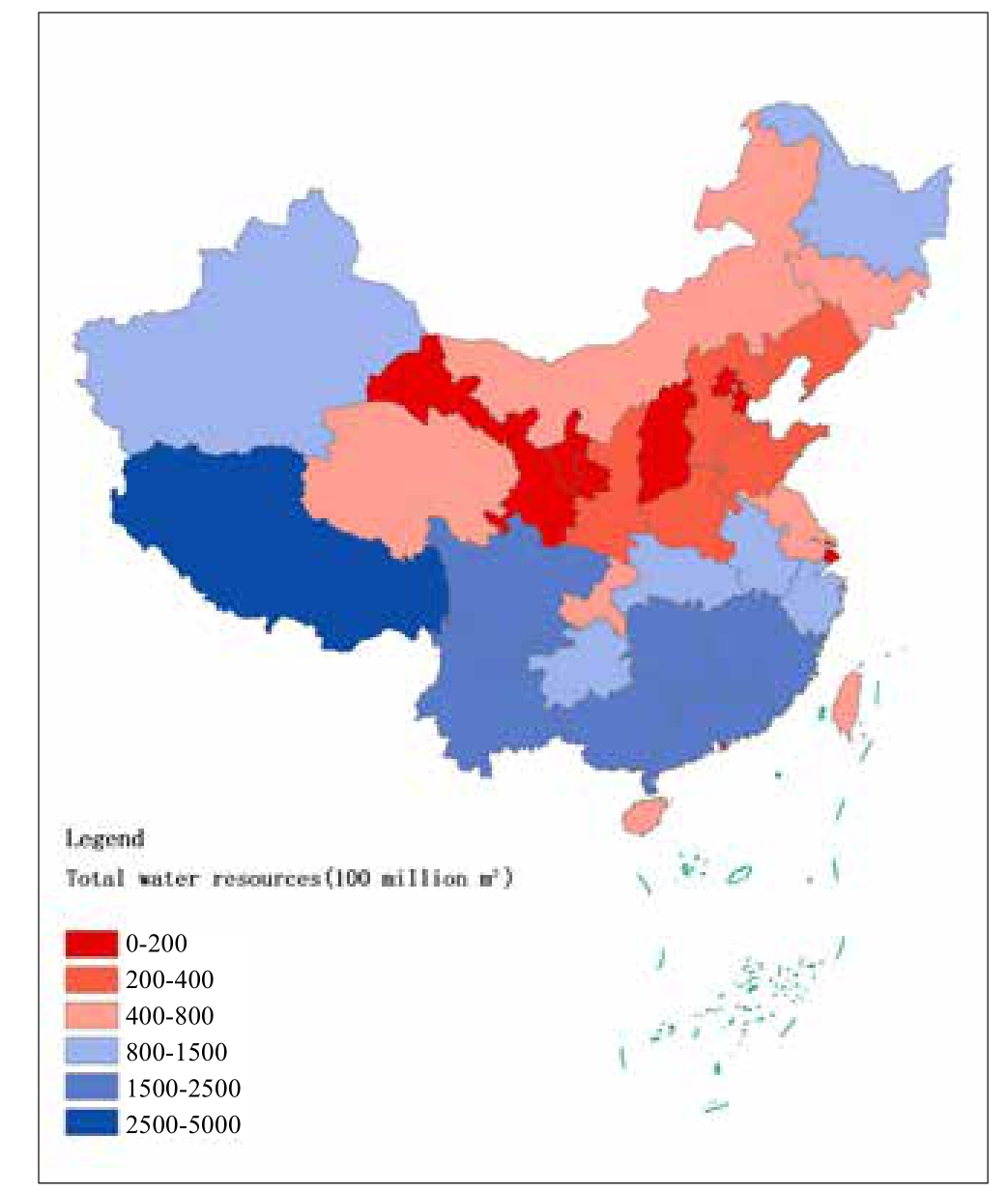
Fig.1 Total water resources (100 million m3) based on cartographic data from the National Bureau of Statistics
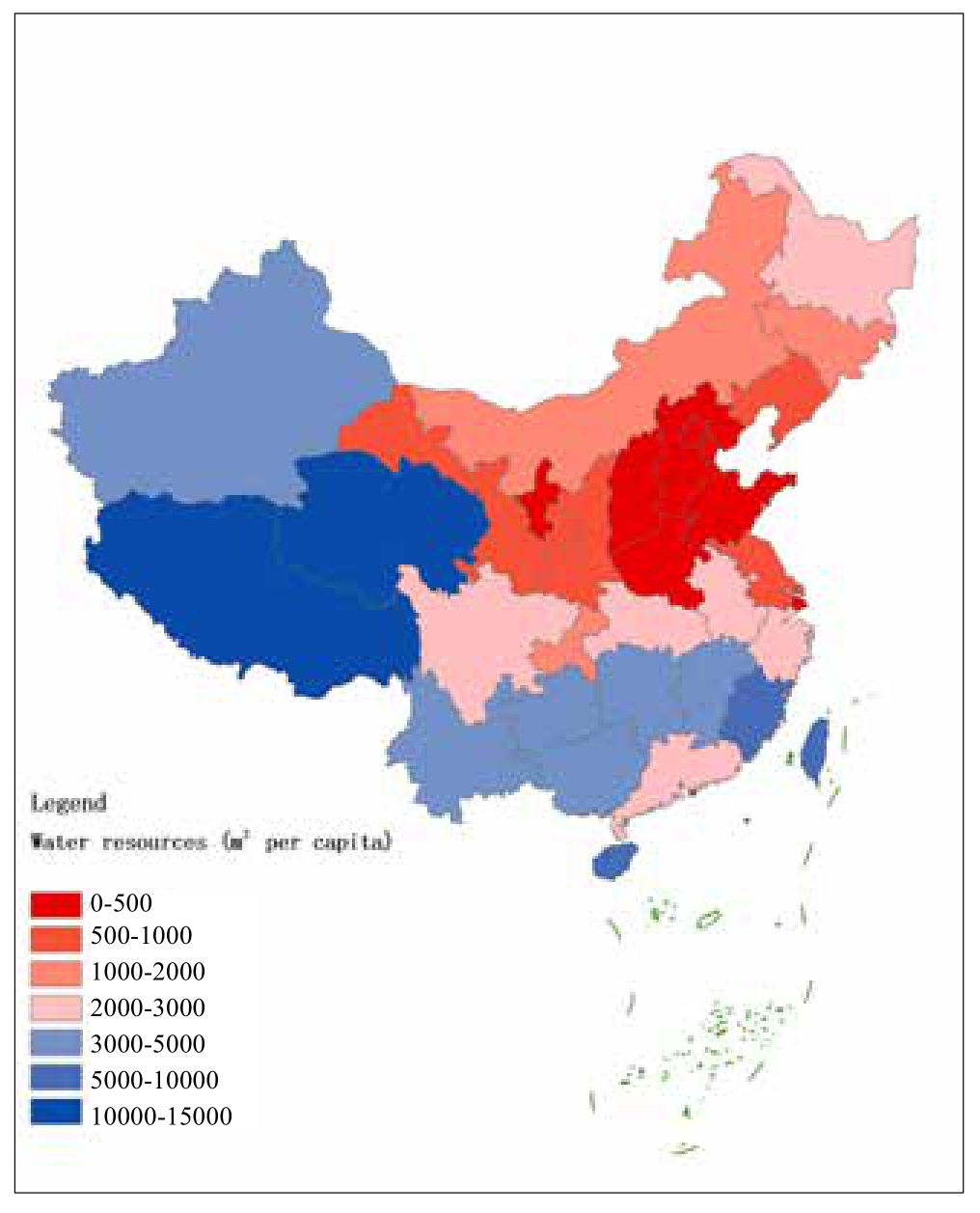
Fig.2 Water resources per capita (cubic meters) based on cartographic data from the National Bureau of Statistics
Fig.1 and Fig.2 describe the amount and distribution of water resources (total and per capita) in China.In 2016,China's total annual water resources was 3,246.64 billion m3.Although China has a large amount of water resources,the per capita water consumption is low because of its large population,and the drinkable water resources are limited.The uneven distribution of precipitation has caused an imbalance in the water supply.The cultivated land in the Yangtze River Basin and south of the Yangtze River accounts for 36% of the country but 80% of the water resources.Meanwhile,northern China has only 8% of the water resources but 40% of the cultivated land.Water shortages and an imbalanced water distribution have become controlling factors hindering economic growth and sustainable development [11].

Fig.1 Total water resources (100 million m3) based on cartographic data from the National Bureau of Statistics

Fig.2 Water resources per capita (cubic meters) based on cartographic data from the National Bureau of Statistics
Fig.1 and Fig.2 describe the amount and distribution of water resources (total and per capita) in China.In 2016,China's total annual water resources was 3,246.64 billion m3.Although China has a large amount of water resources,the per capita water consumption is low because of its large population,and the drinkable water resources are limited.The uneven distribution of precipitation has caused an imbalance in the water supply.The cultivated land in the Yangtze River Basin and south of the Yangtze River accounts for 36% of the country but 80% of the water resources.Meanwhile,northern China has only 8% of the water resources but 40% of the cultivated land.Water shortages and an imbalanced water distribution have become controlling factors hindering economic growth and sustainable development [11].
2.2 Desalination in China
Seawater desalination has been studied in China since 1958,and medium- and large-scale seawater desalination plants have been developed since 1975.In recent years,the overall scale of desalination projects in China has grown steadily.By the end of 2017,136 seawater desalination projects were completed nationwide with a project scale of 1,189,105 tons/d.Five new desalination projects were completed nationwide in 2017,and the scale of the new desalination projects was 1040 tons/d [12].According to the In-depth Research and Investment Strategic Planning Analysis Report on China's Desalination Industry in 2018-2023,RO accounted for 65% of the total freshwater production,followed by MED at 34% and MSF and ED at 1%.RO technology occupies the leading position in China's desalination industry.
At the end of 2017,national desalination projects were distributed in nine coastal provinces and cities,as shown in Fig.3,where water resources were seriously drained.The north is dominated by large-scale industrial desalination projects that are mainly for high-water consumption industries such as electricity and steel in Tianjin,Shandong,Hebei,etc..The southern desalination projects,which are mainly 100 and 1000 tons,were mostly established on islands in Zhejiang and other places.
China's desalination capacity does not rank highly globally; hence,developmental changes are essential to compare favorably with the global level.Most desalination plants in China mainly use RO technology in small-scale industries to obtain freshwater from seawater.
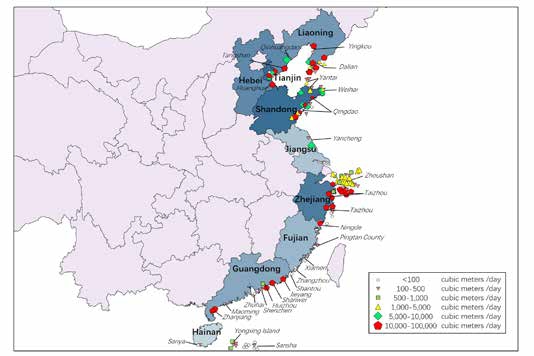
Fig.3 Seawater desalination distribution in China (2017)
Seawater desalination has been studied in China since 1958,and medium- and large-scale seawater desalination plants have been developed since 1975.In recent years,the overall scale of desalination projects in China has grown steadily.By the end of 2017,136 seawater desalination projects were completed nationwide with a project scale of 1,189,105 tons/d.Five new desalination projects were completed nationwide in 2017,and the scale of the new desalination projects was 1040 tons/d [12].According to the In-depth Research and Investment Strategic Planning Analysis Report on China's Desalination Industry in 2018-2023,RO accounted for 65% of the total freshwater production,followed by MED at 34% and MSF and ED at 1%.RO technology occupies the leading position in China's desalination industry.
At the end of 2017,national desalination projects were distributed in nine coastal provinces and cities,as shown in Fig.3,where water resources were seriously drained.The north is dominated by large-scale industrial desalination projects that are mainly for high-water consumption industries such as electricity and steel in Tianjin,Shandong,Hebei,etc..The southern desalination projects,which are mainly 100 and 1000 tons,were mostly established on islands in Zhejiang and other places.
China's desalination capacity does not rank highly globally; hence,developmental changes are essential to compare favorably with the global level.Most desalination plants in China mainly use RO technology in small-scale industries to obtain freshwater from seawater.

Fig.3 Seawater desalination distribution in China (2017)
3 Solar energy in China
Fig.4 shows the annual sunshine hours in China in 2016.The map clearly shows a sufficient supply of solar energy.In Liaoning,Hebei,Tianjin,and Shandong,which have well-developed large-scale desalination projects,the sunshine hours are enough to drive desalination process.Other coastal provinces such as Jiangsu,Zhejiang,Fujian,Guangdong,Hainan,and Taiwan have sufficient sunshine hours for 100- and 1000-ton desalination projects.Therefore,China receives sufficient solar energy to drive the desalination process.
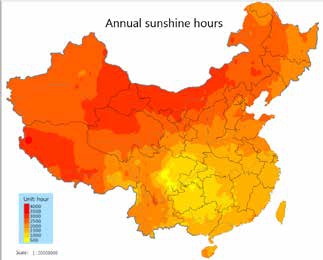
Fig.4 Annual sunshine hours in China (2016)
Source:National Meteorological Information Center
Fig.4 shows the annual sunshine hours in China in 2016.The map clearly shows a sufficient supply of solar energy.In Liaoning,Hebei,Tianjin,and Shandong,which have well-developed large-scale desalination projects,the sunshine hours are enough to drive desalination process.Other coastal provinces such as Jiangsu,Zhejiang,Fujian,Guangdong,Hainan,and Taiwan have sufficient sunshine hours for 100- and 1000-ton desalination projects.Therefore,China receives sufficient solar energy to drive the desalination process.

Fig.4 Annual sunshine hours in China (2016)
Source:National Meteorological Information Center
4 Solar desalination
Sustainable energy is an alternative solution to the decreasing reserves of fossil fuels.Solar energy is an inexhaustible resource that can be used to drive seawater desalination,mainly due to its thermal and optical effects[13].Conventionally,there are two main methods of using solar energy:solar photovoltaics (PV) directly converts sunlight into electricity,while concentrated solar power(CSP) or concentrated photovoltaics (CPV) uses mirrors to reflect sunlight and focus it in a receiver to be transformed into thermal energy.Steam is produced to impulse a turbine engine and drive the generator to produce electric power [14].
The technologies of using solar energy have improved,which had led to the development of energy-desalination coupling schemes.These can be divided into indirect and direct processes according to whether the solar energy collection and desalination are carried out with the same device,as shown in Fig.5.Direct processes mainly include solar distillation (SD),solar HDH,and solar chimney (SC);solar power is collected and utilized as thermal energy,and the desalination process is carried out by the same device.
In an indirect process,solar collection is separate from desalination.Solar power can be converted into heat by a solar collector or into electricity by PV power generation[15].Indirect processes include thermally driven MSF desalination,MED,VC desalination,membrane distillation(MD),freeze desalination (FD),and adsorption desalination(AD) as well as electrically driven RO and ED.
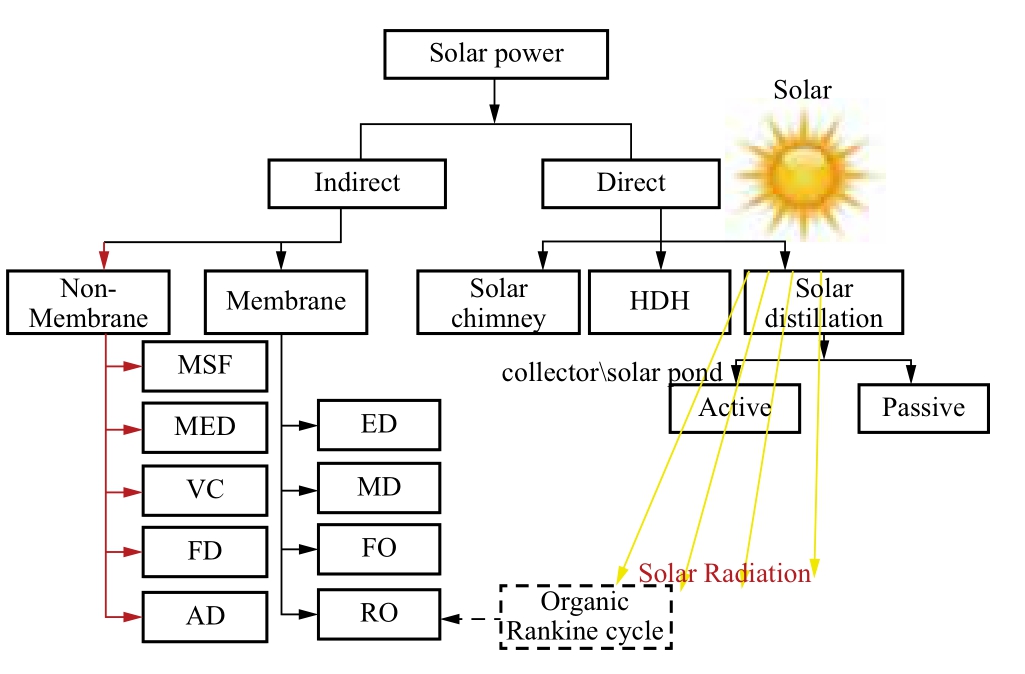
Fig.5 Schematic of solar power coupled with desalination
Sustainable energy is an alternative solution to the decreasing reserves of fossil fuels.Solar energy is an inexhaustible resource that can be used to drive seawater desalination,mainly due to its thermal and optical effects[13].Conventionally,there are two main methods of using solar energy:solar photovoltaics (PV) directly converts sunlight into electricity,while concentrated solar power(CSP) or concentrated photovoltaics (CPV) uses mirrors to reflect sunlight and focus it in a receiver to be transformed into thermal energy.Steam is produced to impulse a turbine engine and drive the generator to produce electric power [14].
The technologies of using solar energy have improved,which had led to the development of energy-desalination coupling schemes.These can be divided into indirect and direct processes according to whether the solar energy collection and desalination are carried out with the same device,as shown in Fig.5.Direct processes mainly include solar distillation (SD),solar HDH,and solar chimney (SC);solar power is collected and utilized as thermal energy,and the desalination process is carried out by the same device.
In an indirect process,solar collection is separate from desalination.Solar power can be converted into heat by a solar collector or into electricity by PV power generation[15].Indirect processes include thermally driven MSF desalination,MED,VC desalination,membrane distillation(MD),freeze desalination (FD),and adsorption desalination(AD) as well as electrically driven RO and ED.

Fig.5 Schematic of solar power coupled with desalination
4.1 Direct desalination processes
4.1.1 Solar chimney
The SC power station (SCPP) is an important method for realizing the large-scale development and utilization of solar energy.The main components of a SC are largediameter solar collectors,a turbine,a generator,and a long chimney [18],as shown in Fig.6.The bottom layer of the heat-collecting shed and the seawater layer absorb most of the solar radiation energy,which increases the temperature of the seawater layer and intensifies the evaporation process.This generates a large amount of steam in the upper space of the heat collecting shed and produces moist air that rotates a turbine at the bottom of the chimney as it rises to generate electricity.The temperature drops,and liquid water condenses on the outer surface of the bundle when the wet air is exothermic [19,20].The mass flow rate was given by

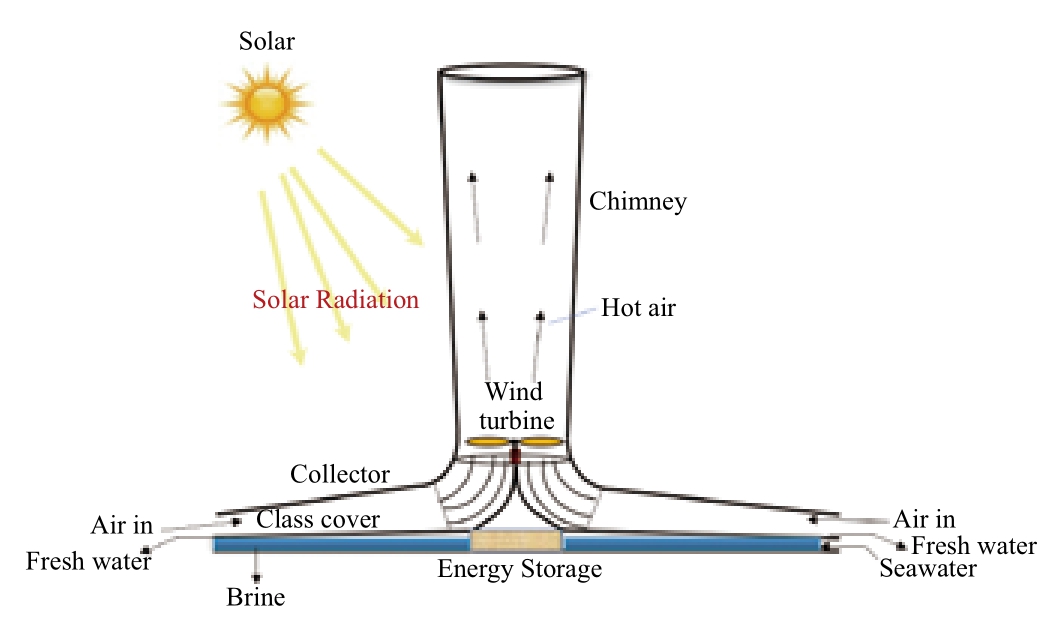
Fig.6 Schematic diagram of a desalination system integrated with a solar chimney
The possible power output of the SCPP [21] is given by

The collector efficiency was studied by Koonsrisuk et al.[22] with mathematical models and is defined as

Table1 compares SC desalination systems.The infrastructure cost of the SC desalination system was analyzed by [23] and includes a collector (€9/m2),chimney(€250/m2),wind turbine generator (€0.5 million),and distillation pond (€18/m2).These costs include materials,transportation,and construction.In Northwest China,which has abundant solar energy resources,the average annual sunshine time is 2800-3300 h.The large amounts of barren land,such as the Gobi Desert,are suitable for building large-scale SCPPs.
Table1 Comparison of solar chimney desalination systems
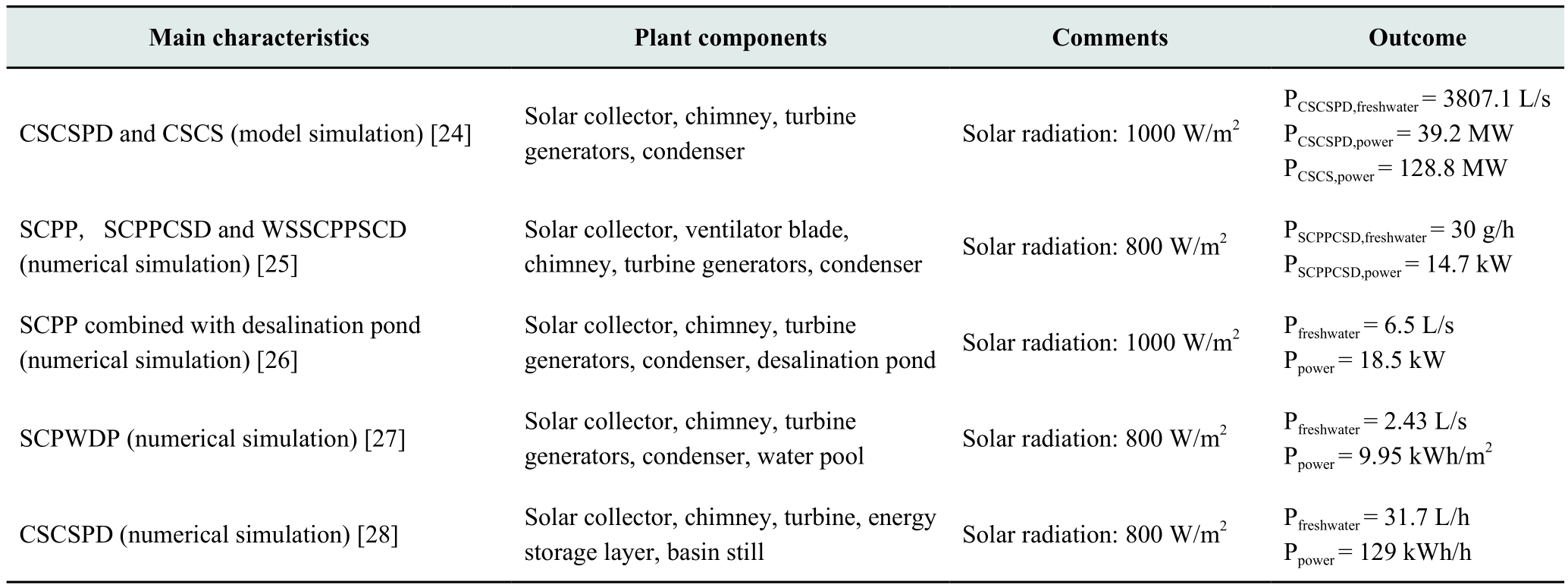
CSCSPD:Combined solar chimney system for power generation and seawater desalination; CSCS:Classical solar chimney power system; SCPP:Solar chimney power plant; SCPPCSD:Solar chimney power plant combined with seawater desalination; WSSCPPSCD:Wind supercharged solar chimney power plant combined with seawater desalination; SCPWDP:Solar chimney power-water distillation plant.
4.1.2 Solar distillation
SD is gradually becoming the most widely used direct process; it has a simple structure,easy and flexible operation,and low consumption of conventional energy.It boasts technical and economic competitiveness and is accessible for remote coastal areas with high solar irradiance and limited primary energy supply.Its application started in 1872,when Wilson designed the first conventional solar still in Chile [29].SD can be divided into passive and active modes depending on whether or not a solar power collector is used[30].By coupling solar stills with auxiliary equipment such as sponge cubes [31],condensers,concave and convex surfaces,sun tracking,flat plates,evacuated tube collectors,phase change materials (PCMs) and reflectors [32],the heat and mass transfer process inside the system can be effectively improved.In addition,the recovery and utilization(i.e.,reuse) of the internal latent heat of condensation and distillate yield can be increased.
SD is the subject of great interest.The improved performance of solar stills has led to the development of different designs of solar stills:double,triple,and multieffect solar stills; vertical stills; tubular-type solar stills;finned and crinkled stills; and stepped-type solar stills [33-38].Fig.7 shows some types of solar stills.Table2 presents SD technologies.
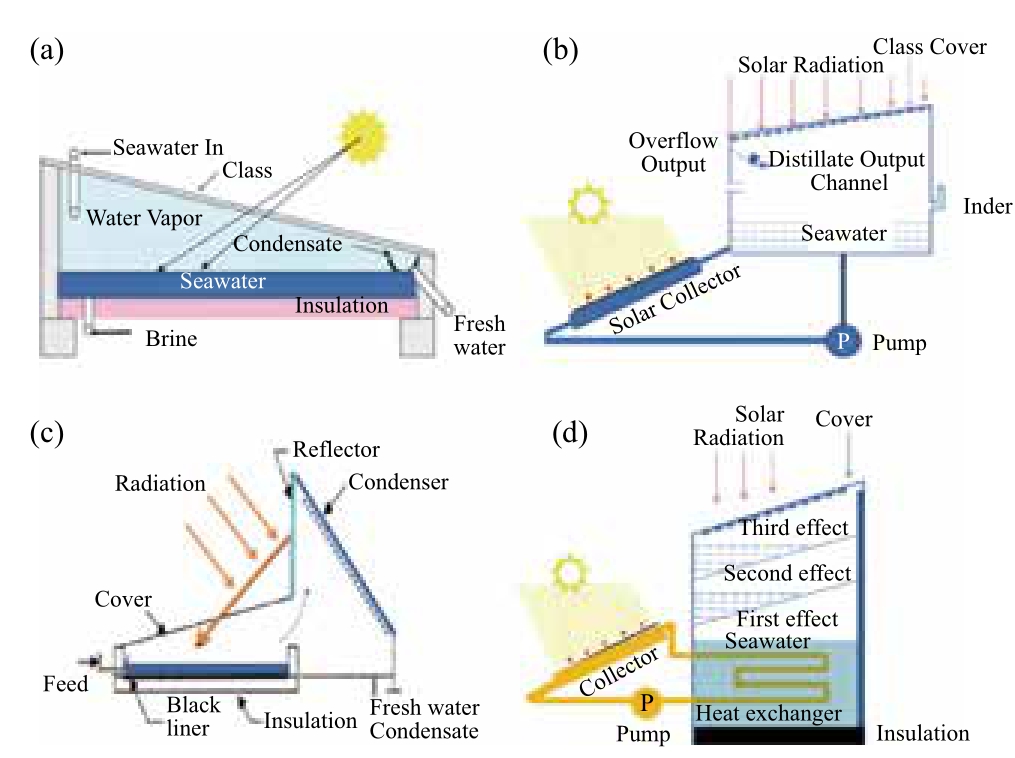
Fig.7 Schematics of solar stills:(a) single stage solar still,(b) solar still with collector,(c) solar still with condenser,and(d) multi-stage solar still [109]
Table2 Technologies of solar distillation
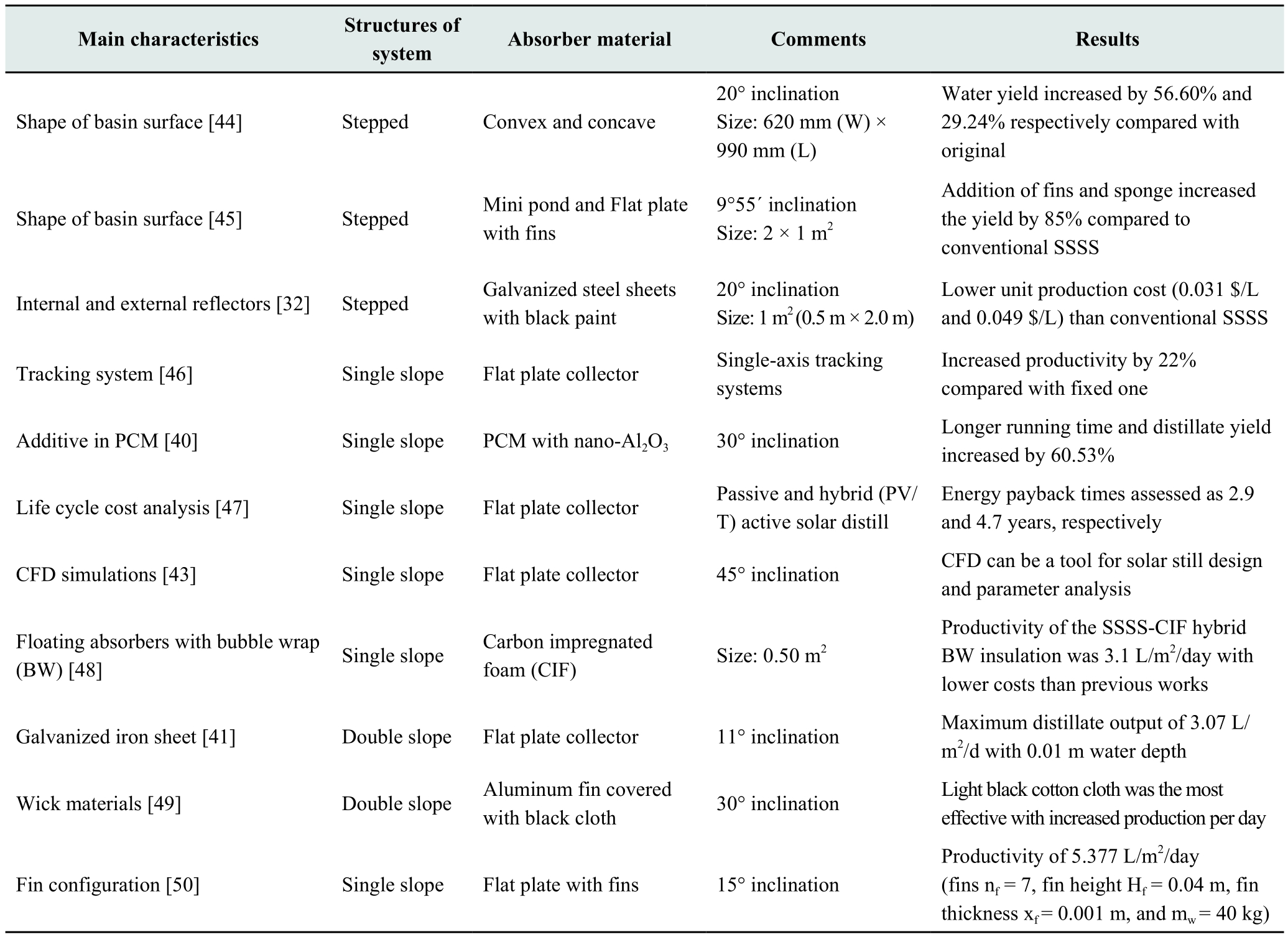
Additives can effectively increase the overall performance of the system.The performance of a single basin SD system was evaluated with different energy absorber materials,and the experimental results showed that the addition of potassium dichromate (K2Cr2O7) to the basin effectively enhanced the solar radiation flux and basin temperature[39].Furthermore,adding nano-Al2O3 to the PCM increased the running time; the distillate yield increased by 60.53%compared to that the simple distiller [40].The impact of the structure of the condensing surface on the distillate output has been studied.Experiments were carried out to examine the difference in productivity between single-slope and double-slope solar stills,and the results were 2.34 and 3.07 (L/m2)/day,respectively [41,42].The operating principle of the inverted absorber solar still,wick-type solar still,and solar still incorporating compound parabolic concentrator (CPC)systems were identified.
4.1.1 Solar chimney
The SC power station (SCPP) is an important method for realizing the large-scale development and utilization of solar energy.The main components of a SC are largediameter solar collectors,a turbine,a generator,and a long chimney [18],as shown in Fig.6.The bottom layer of the heat-collecting shed and the seawater layer absorb most of the solar radiation energy,which increases the temperature of the seawater layer and intensifies the evaporation process.This generates a large amount of steam in the upper space of the heat collecting shed and produces moist air that rotates a turbine at the bottom of the chimney as it rises to generate electricity.The temperature drops,and liquid water condenses on the outer surface of the bundle when the wet air is exothermic [19,20].The mass flow rate was given by

Fig.6 Schematic diagram of a desalination system integrated with a solar chimney
The possible power output of the SCPP [21] is given by
The collector efficiency was studied by Koonsrisuk et al.[22] with mathematical models and is defined as
Table1 compares SC desalination systems.The infrastructure cost of the SC desalination system was analyzed by [23] and includes a collector (€9/m2),chimney(€250/m2),wind turbine generator (€0.5 million),and distillation pond (€18/m2).These costs include materials,transportation,and construction.In Northwest China,which has abundant solar energy resources,the average annual sunshine time is 2800-3300 h.The large amounts of barren land,such as the Gobi Desert,are suitable for building large-scale SCPPs.
Table1 Comparison of solar chimney desalination systems

CSCSPD:Combined solar chimney system for power generation and seawater desalination; CSCS:Classical solar chimney power system; SCPP:Solar chimney power plant; SCPPCSD:Solar chimney power plant combined with seawater desalination; WSSCPPSCD:Wind supercharged solar chimney power plant combined with seawater desalination; SCPWDP:Solar chimney power-water distillation plant.
4.1.2 Solar distillation
SD is gradually becoming the most widely used direct process; it has a simple structure,easy and flexible operation,and low consumption of conventional energy.It boasts technical and economic competitiveness and is accessible for remote coastal areas with high solar irradiance and limited primary energy supply.Its application started in 1872,when Wilson designed the first conventional solar still in Chile [29].SD can be divided into passive and active modes depending on whether or not a solar power collector is used[30].By coupling solar stills with auxiliary equipment such as sponge cubes [31],condensers,concave and convex surfaces,sun tracking,flat plates,evacuated tube collectors,phase change materials (PCMs) and reflectors [32],the heat and mass transfer process inside the system can be effectively improved.In addition,the recovery and utilization(i.e.,reuse) of the internal latent heat of condensation and distillate yield can be increased.
SD is the subject of great interest.The improved performance of solar stills has led to the development of different designs of solar stills:double,triple,and multieffect solar stills; vertical stills; tubular-type solar stills;finned and crinkled stills; and stepped-type solar stills [33-38].Fig.7 shows some types of solar stills.Table2 presents SD technologies.

Fig.7 Schematics of solar stills:(a) single stage solar still,(b) solar still with collector,(c) solar still with condenser,and(d) multi-stage solar still [109]
Table2 Technologies of solar distillation

Additives can effectively increase the overall performance of the system.The performance of a single basin SD system was evaluated with different energy absorber materials,and the experimental results showed that the addition of potassium dichromate (K2Cr2O7) to the basin effectively enhanced the solar radiation flux and basin temperature[39].Furthermore,adding nano-Al2O3 to the PCM increased the running time; the distillate yield increased by 60.53%compared to that the simple distiller [40].The impact of the structure of the condensing surface on the distillate output has been studied.Experiments were carried out to examine the difference in productivity between single-slope and double-slope solar stills,and the results were 2.34 and 3.07 (L/m2)/day,respectively [41,42].The operating principle of the inverted absorber solar still,wick-type solar still,and solar still incorporating compound parabolic concentrator (CPC)systems were identified.
4.2 Indirect desalination processes
The desalination process has a very high energy requirement.The minimum energy required for the desalination process is much greater than the theoretical value that could be acquired with the second law of thermodynamics.If RO technology is taken as an example,the minimum theoretical required energy for desalinating seawater with a salinity of 45,000 mg/L is around 1 kWh/m3 [3,51].Table3 compares the energy consumptions of various desalination processes.There is much room for further desalination technologies that are environmentally friendly and energy-efficient.
RO desalination has increased in popularity because of advances in membrane technology and its high recovery ratio (RR) and low specific energy consumption.In terms of solar-powered desalination,Solar-RO comprises 52%of indirect solar desalination plants with Solar-MED and Solar-MSF making up 13% and 9%,respectively,around the world.Solar-ED makes up 9% of the total and is suitable for brackish water desalination.Solar-MD represent 16% of the total and has seen promising developments[15].RO accounts for 65% of the total water production,MED accounts for 34%,and MSF and ED account for 1%,as shown in Fig.8.RO technology has a leading rolein desalination in China.In recent years,indirect solarpowered desalination technologies have been studied.A comprehensive review of indirect solar desalination is presented below.
Table3 Comparison of different desalination technologies


Fig.8 Worldwide desalination technologies powered by indirect solar energy (left) and desalination technologies used in China (right)
4.2.1 Solar powered multi-effect distillation
The origins of MED can be traced back to the 1830s.However,in the early stages of MED,it was constrained by a proneness to scaling on the heat transfer surface; it was not until the 1960s that the development of low-temperature MED (LT-MED) technology eased the problems of scaling and corrosion.The MED process [52] is based on using the latent heat of steam in the first cell as a dynamic source to drive seawater evaporation and provide a heat source in the next cell; this is repeated in the following cells until the minimum temperature is reached.Horizontal-tube falling film evaporators are used to eliminate the influence of static pressure on the evaporation surface and increase the total heat transfer coefficient.This allows operation at low temperatures (top brine temperature (TBT) is 65-70 °C)and limits scale formation on the walls [53,54].Frantz et al.[55] performed numerical simulations to systematically study the correlation of parameters in a solar-MED system.The results showed that the freshwater yield can be doubled when the steam is heated from 65 °C to 90 °C,and the yield can be increased by 50% if the surface area is augmented by 30%.Table4 shows the technologies of solar-MED.The process requires both thermal energy and mechanical energy.Most studies have focused on the reliability and technical feasibility of applying solar thermal technology to seawater desalination using different solar collector and coupled forms.Fig.9 shows a schematic diagram of solar-MED components.
Table4 Technologies of solar MED

continue

ETC:Evacuated tube collector; PTC:Parabolic trough collector; CPC:compound parabolic collector; DEAHP:double-effect absorption heat pump;ORC:organic Rankine cycle; RC:Rankine cycle; CRC:Clausius-Rankine cycle.
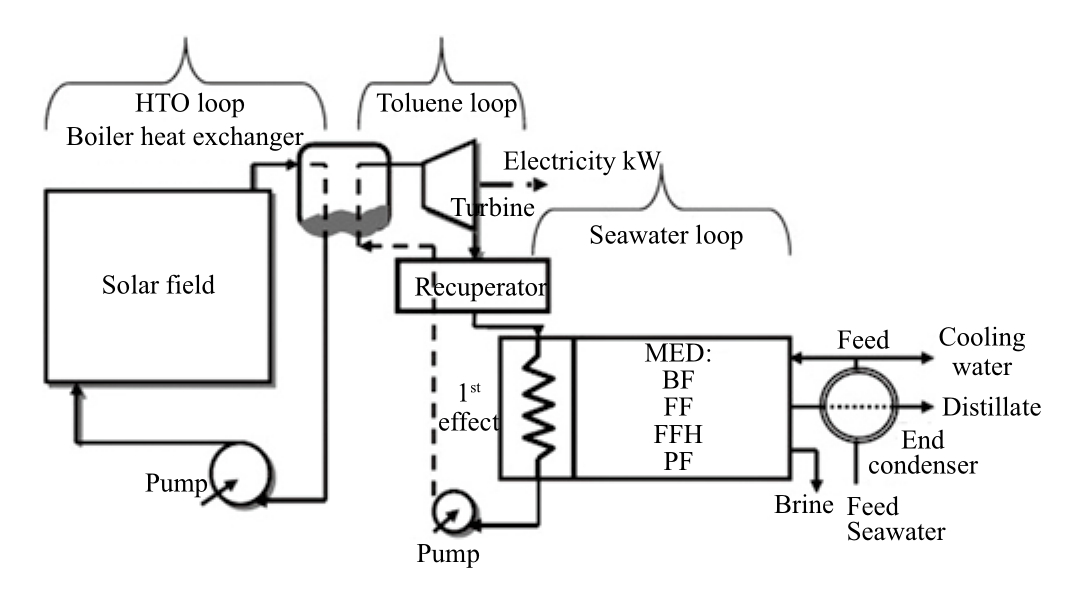
Fig.9 Schematic diagram of solar-MED components for desalination and power generation:solar field,boiler heat exchanger,pump,turbine,recuperator,and MED [110]
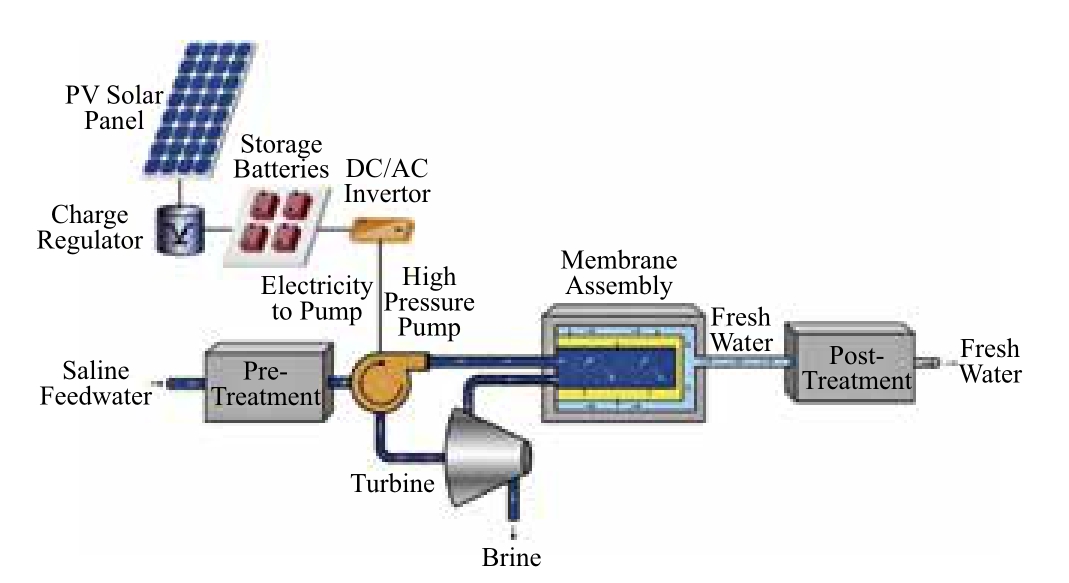
Fig.10 Operating principle of the solar-powered reverse osmosis (RO) system [111]
4.2.2 Solar-powered reverse osmosis
RO is the most common desalination technique owing to its low energy cost and installed capacity.It is a pressuredriven desalination process where feed water is forced across a semi-permeable membrane module; freshwater is collected,and the brine is drained [60-62].The required seawater RO (SWRO) desalination productivity to meet the global water demand in 2030 is estimated to be approximately 2374 million m3/day [63].The common energy consumption of a SWRO desalination plant is approximately 2-4 kWh/m3 and depends on the feed water salinity,RR,pretreatment,brine discharge,and electric power used within the plant [64].
Combining solar energy and RO will effectively reduce the consumption of conventional energy sources and promote the sustainable development of seawater desalination.At present,this approach can be divided into two types:PV-powered and solar thermal-powered RO desalination [65,66].Fig.10 shows schematic representations of these systems.
PV powered RO desalination relies on PV modules to convert heat generated by solar radiation into electricity to drive a water pump [67].The heat can also be converted into mechanical energy through an organic Rankine cycle (ORC)to drive the high-pressure pump in the RO system; this is known as solar thermal-powered RO desalination.Waste heat can increase the temperature of the feed liquid,which helps increase the membrane permeate flux [68,69].This is a cost-effective way to realize a commercial application of sustainable energy to small-scale RO desalination systems.
Some researchers have used small-scale PV-RO desalination systems in remote areas that can produce 0.51 m3/h while consuming 1.1 kWh/m3.Compared with dieselpowered RO system,a PV-powered RO system can produce water at a lower cost [70,71].
The mass flux that is transported across the RO membrane is given by [72]

Many places still need the construction of freshwater production plants,especially in remote areas.In [73],it was pointed out that PV-powered RO is theoretically feasible for the majority of remote locations with large solar resources based on Geographic Information System (GIS) data.Table5 compares different solar-RO technologies.RO is a mainstream desalination technology; the energy recovery system occupies a vital role.The maximum system recovery can reach around 80%.Creative methods and materials are important for developing membranes that can meet the stringent permeability and selectivity requirements; these include biomimetic membranes as well as graphene and 2D membranes.These advances can help decrease the specific desalination costs of small-scale units.
Table5 Solar-RO technologies
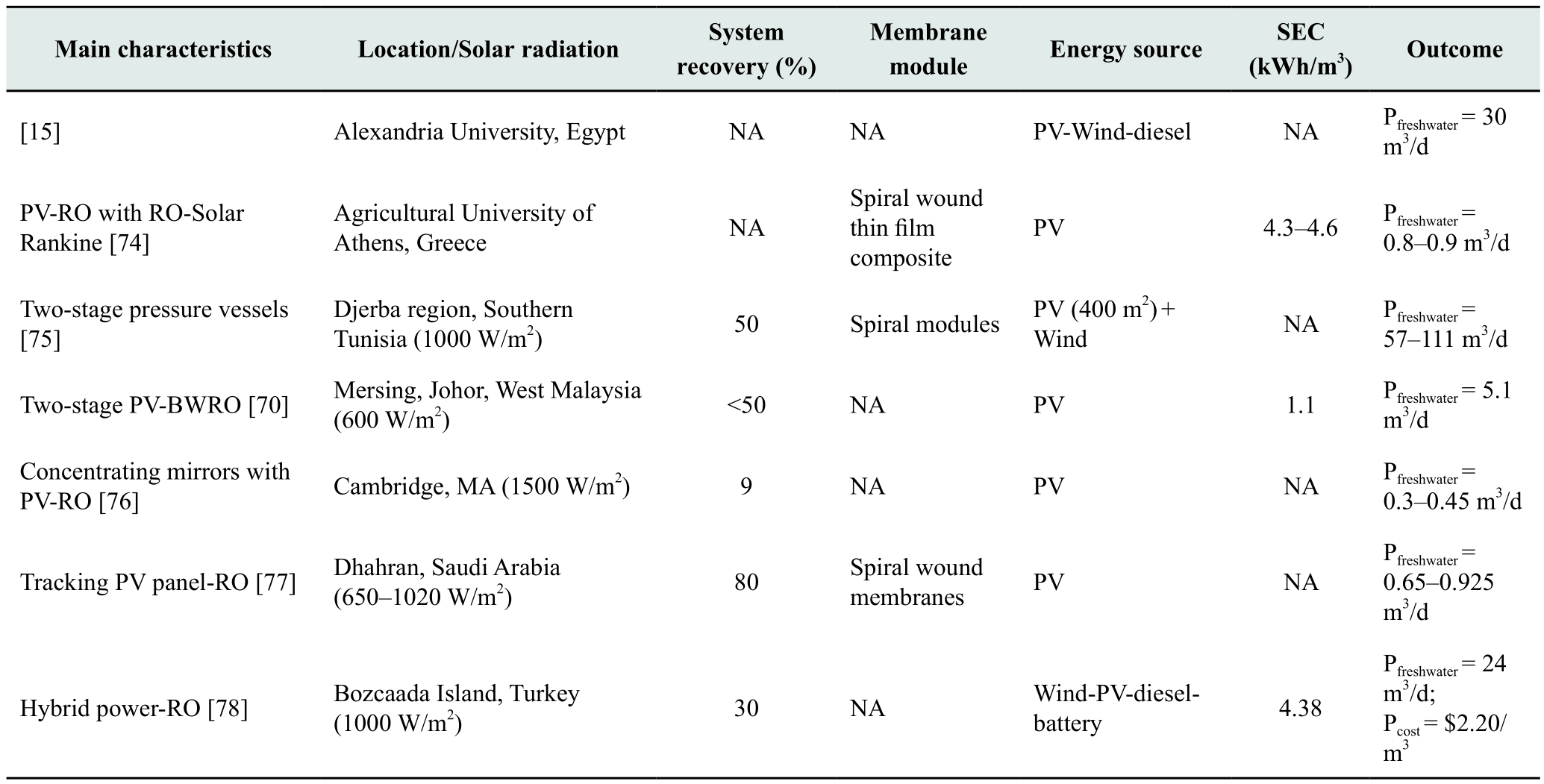
SEC:specific energy consumption; BWRO:brackish water reverse osmosis.
The desalination process has a very high energy requirement.The minimum energy required for the desalination process is much greater than the theoretical value that could be acquired with the second law of thermodynamics.If RO technology is taken as an example,the minimum theoretical required energy for desalinating seawater with a salinity of 45,000 mg/L is around 1 kWh/m3 [3,51].Table3 compares the energy consumptions of various desalination processes.There is much room for further desalination technologies that are environmentally friendly and energy-efficient.
RO desalination has increased in popularity because of advances in membrane technology and its high recovery ratio (RR) and low specific energy consumption.In terms of solar-powered desalination,Solar-RO comprises 52%of indirect solar desalination plants with Solar-MED and Solar-MSF making up 13% and 9%,respectively,around the world.Solar-ED makes up 9% of the total and is suitable for brackish water desalination.Solar-MD represent 16% of the total and has seen promising developments[15].RO accounts for 65% of the total water production,MED accounts for 34%,and MSF and ED account for 1%,as shown in Fig.8.RO technology has a leading rolein desalination in China.In recent years,indirect solarpowered desalination technologies have been studied.A comprehensive review of indirect solar desalination is presented below.
Table3 Comparison of different desalination technologies


Fig.8 Worldwide desalination technologies powered by indirect solar energy (left) and desalination technologies used in China (right)
4.2.1 Solar powered multi-effect distillation
The origins of MED can be traced back to the 1830s.However,in the early stages of MED,it was constrained by a proneness to scaling on the heat transfer surface; it was not until the 1960s that the development of low-temperature MED (LT-MED) technology eased the problems of scaling and corrosion.The MED process [52] is based on using the latent heat of steam in the first cell as a dynamic source to drive seawater evaporation and provide a heat source in the next cell; this is repeated in the following cells until the minimum temperature is reached.Horizontal-tube falling film evaporators are used to eliminate the influence of static pressure on the evaporation surface and increase the total heat transfer coefficient.This allows operation at low temperatures (top brine temperature (TBT) is 65-70 °C)and limits scale formation on the walls [53,54].Frantz et al.[55] performed numerical simulations to systematically study the correlation of parameters in a solar-MED system.The results showed that the freshwater yield can be doubled when the steam is heated from 65 °C to 90 °C,and the yield can be increased by 50% if the surface area is augmented by 30%.Table4 shows the technologies of solar-MED.The process requires both thermal energy and mechanical energy.Most studies have focused on the reliability and technical feasibility of applying solar thermal technology to seawater desalination using different solar collector and coupled forms.Fig.9 shows a schematic diagram of solar-MED components.
Table4 Technologies of solar MED

continue

ETC:Evacuated tube collector; PTC:Parabolic trough collector; CPC:compound parabolic collector; DEAHP:double-effect absorption heat pump;ORC:organic Rankine cycle; RC:Rankine cycle; CRC:Clausius-Rankine cycle.

Fig.9 Schematic diagram of solar-MED components for desalination and power generation:solar field,boiler heat exchanger,pump,turbine,recuperator,and MED [110]

Fig.10 Operating principle of the solar-powered reverse osmosis (RO) system [111]
4.2.2 Solar-powered reverse osmosis
RO is the most common desalination technique owing to its low energy cost and installed capacity.It is a pressuredriven desalination process where feed water is forced across a semi-permeable membrane module; freshwater is collected,and the brine is drained [60-62].The required seawater RO (SWRO) desalination productivity to meet the global water demand in 2030 is estimated to be approximately 2374 million m3/day [63].The common energy consumption of a SWRO desalination plant is approximately 2-4 kWh/m3 and depends on the feed water salinity,RR,pretreatment,brine discharge,and electric power used within the plant [64].
Combining solar energy and RO will effectively reduce the consumption of conventional energy sources and promote the sustainable development of seawater desalination.At present,this approach can be divided into two types:PV-powered and solar thermal-powered RO desalination [65,66].Fig.10 shows schematic representations of these systems.
PV powered RO desalination relies on PV modules to convert heat generated by solar radiation into electricity to drive a water pump [67].The heat can also be converted into mechanical energy through an organic Rankine cycle (ORC)to drive the high-pressure pump in the RO system; this is known as solar thermal-powered RO desalination.Waste heat can increase the temperature of the feed liquid,which helps increase the membrane permeate flux [68,69].This is a cost-effective way to realize a commercial application of sustainable energy to small-scale RO desalination systems.
Some researchers have used small-scale PV-RO desalination systems in remote areas that can produce 0.51 m3/h while consuming 1.1 kWh/m3.Compared with dieselpowered RO system,a PV-powered RO system can produce water at a lower cost [70,71].
The mass flux that is transported across the RO membrane is given by [72]
Many places still need the construction of freshwater production plants,especially in remote areas.In [73],it was pointed out that PV-powered RO is theoretically feasible for the majority of remote locations with large solar resources based on Geographic Information System (GIS) data.Table5 compares different solar-RO technologies.RO is a mainstream desalination technology; the energy recovery system occupies a vital role.The maximum system recovery can reach around 80%.Creative methods and materials are important for developing membranes that can meet the stringent permeability and selectivity requirements; these include biomimetic membranes as well as graphene and 2D membranes.These advances can help decrease the specific desalination costs of small-scale units.
Table5 Solar-RO technologies

SEC:specific energy consumption; BWRO:brackish water reverse osmosis.
4.3 Solar pond
The solar pond is an energy device that acts as a largescale solar collector to absorb and store solar irradiation as low-grade heat,which can minimize current alarming environmental impacts and energy scarcity [79,80].
A solar pond with three different zones having various densities of saltwater can operate as large thermal batteries.The three zones are called the upper convective zone (UCZ),non-convective middle zone (NCZ),and lower convective zone (LCZ) [81,82].The UCZ is the topmost layer of the solar pond and commonly consists of freshwater close to the ambient temperature; it has the functions of heat insulation and preventing the disturbance of the underlying solution.The NCZ is just below the UCZ with a gradually increasing salt concentration with increasing depth.This layer effectively prevents natural convection in the vertical direction caused by the rising temperature of the water in the lower pool,which minimizes heat losses from the highly saline bottom layer.The LCZ comprises a saturated salt solution with the highest saline density and no concentration gradient.This layer provides heat absorption and storage,and the maximum temperature can reach around 100 °C[83-86].
Solar ponds are mainly divided into two categories:convective and non-convective.A shallow solar pond is a convective solar pond; the salinity gradient solar pond(SGSP),equilibrium solar pond (ESP),solar membrane pond,and solar gel pond are non-convective [87,88].The solar gel pond is generally more costly than the SGSP [89].
The solar pond is an energy storage technology with significant advantages; it eliminates the matching gap between intermittent sustainable energy sources and continuously operating desalination plants.The relation between energy storage and sustainable energy-driven seawater desalination technology was systematically illustrated in [90],which pointed out that the storage media,containers,and thermal insulation should be the focus of future research.Different desalination technologies have been integrated with a solar pond to increase the performance.Solar ponds can be used as thermal batteries for most desalination processes,such as solar pond-driven MSF,MED,distillation,SC,MD,and other thermal desalination technologies.It can also be used as a heat resource for draw solution recovery in FO.Table6 presents coupling systems.The solar pond-driven MSF system is relatively mature and suitable for mass production.
Table6 Selected studies on solar pond assisted desalination technologies
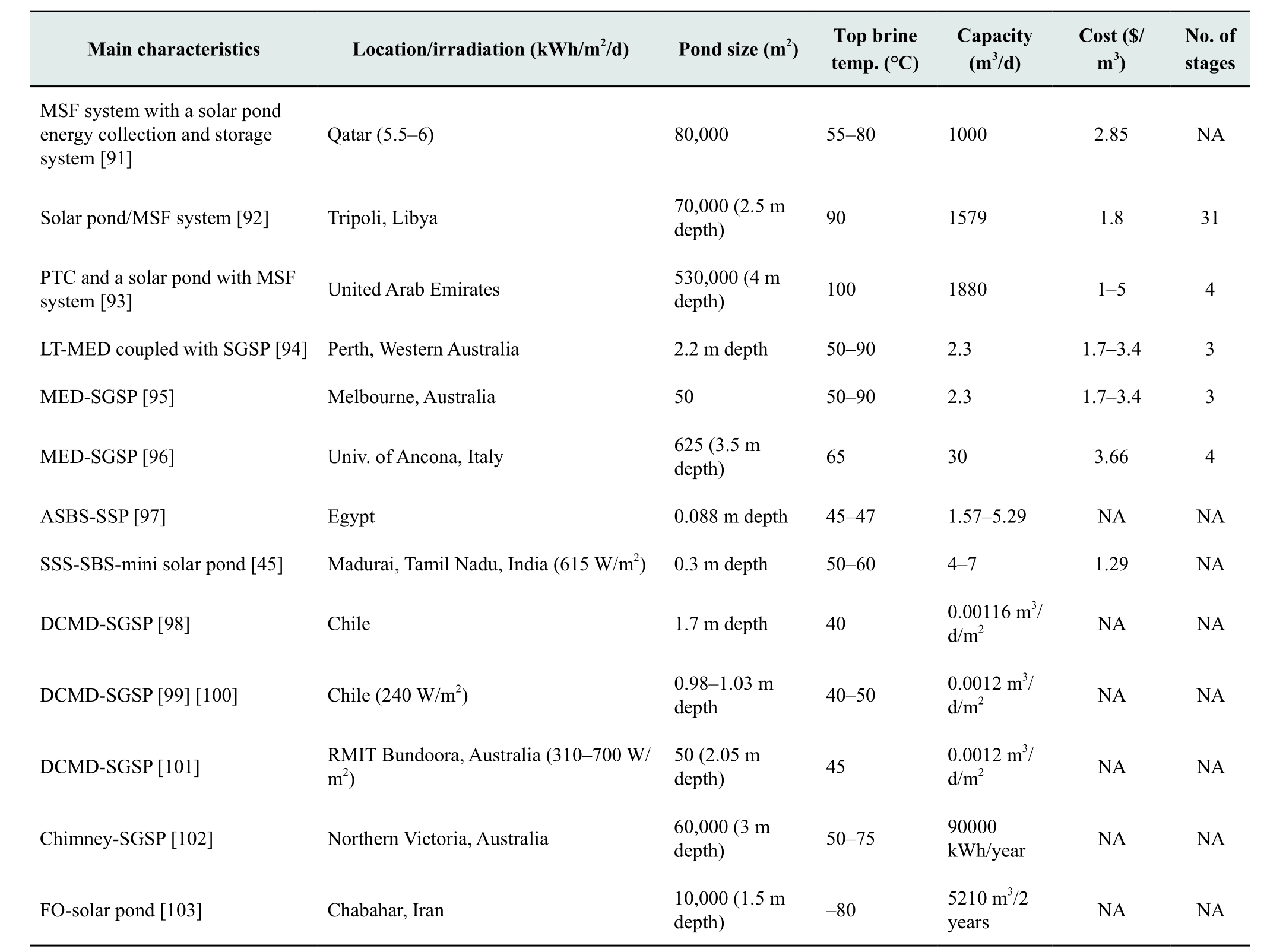
ASBS:active single basin solar still; SSP:shallow solar pond; DCMD:direct contact membrane distillation; SSS:stepped solar still; SBS:single basin solar still
The solar pond is an energy device that acts as a largescale solar collector to absorb and store solar irradiation as low-grade heat,which can minimize current alarming environmental impacts and energy scarcity [79,80].
A solar pond with three different zones having various densities of saltwater can operate as large thermal batteries.The three zones are called the upper convective zone (UCZ),non-convective middle zone (NCZ),and lower convective zone (LCZ) [81,82].The UCZ is the topmost layer of the solar pond and commonly consists of freshwater close to the ambient temperature; it has the functions of heat insulation and preventing the disturbance of the underlying solution.The NCZ is just below the UCZ with a gradually increasing salt concentration with increasing depth.This layer effectively prevents natural convection in the vertical direction caused by the rising temperature of the water in the lower pool,which minimizes heat losses from the highly saline bottom layer.The LCZ comprises a saturated salt solution with the highest saline density and no concentration gradient.This layer provides heat absorption and storage,and the maximum temperature can reach around 100 °C[83-86].
Solar ponds are mainly divided into two categories:convective and non-convective.A shallow solar pond is a convective solar pond; the salinity gradient solar pond(SGSP),equilibrium solar pond (ESP),solar membrane pond,and solar gel pond are non-convective [87,88].The solar gel pond is generally more costly than the SGSP [89].
The solar pond is an energy storage technology with significant advantages; it eliminates the matching gap between intermittent sustainable energy sources and continuously operating desalination plants.The relation between energy storage and sustainable energy-driven seawater desalination technology was systematically illustrated in [90],which pointed out that the storage media,containers,and thermal insulation should be the focus of future research.Different desalination technologies have been integrated with a solar pond to increase the performance.Solar ponds can be used as thermal batteries for most desalination processes,such as solar pond-driven MSF,MED,distillation,SC,MD,and other thermal desalination technologies.It can also be used as a heat resource for draw solution recovery in FO.Table6 presents coupling systems.The solar pond-driven MSF system is relatively mature and suitable for mass production.
Table6 Selected studies on solar pond assisted desalination technologies

ASBS:active single basin solar still; SSP:shallow solar pond; DCMD:direct contact membrane distillation; SSS:stepped solar still; SBS:single basin solar still
5 Discussion
Seawater desalination plays a critical role in increasing the total amount of freshwater,guaranteeing a water supply for coastal and island residents,and providing a stable supply of industrial water.In the near future,conventional energy will continue to be the main power source for seawater desalination,but solar energy can be used as a supplementary source.
Seawater desalination plays a critical role in increasing the total amount of freshwater,guaranteeing a water supply for coastal and island residents,and providing a stable supply of industrial water.In the near future,conventional energy will continue to be the main power source for seawater desalination,but solar energy can be used as a supplementary source.
5.1 Solar system considerations
Given that 70% of the global population lives within 120 km of the ocean,desalination technology is a reasonable approach to addressing water shortages.Desalination improves the water quality,greatly mitigates water shortage problems,and improves the quality of life and economic status.At present,humans mainly use fossil energy.The heavy consumption of fossil fuels has caused serious ecological and environmental problems such as global warming.Moreover,the uncontrolled use of fossil fuels will exhaust the limited reserves.Therefore,demand needs to be controlled,and alternative energy sources need to be developed.
Table7 compares the costs of solar-driven desalination systems.There is still much room for improving the combination of solar energy and desalination technologies;the desalination cost accounts for 10%-20% of the total cost,while the solar system cost makes up 15%-70%.In short,the technical feasibility is normally not an obstacle compared to economic and dependability considerations.
Given that 70% of the global population lives within 120 km of the ocean,desalination technology is a reasonable approach to addressing water shortages.Desalination improves the water quality,greatly mitigates water shortage problems,and improves the quality of life and economic status.At present,humans mainly use fossil energy.The heavy consumption of fossil fuels has caused serious ecological and environmental problems such as global warming.Moreover,the uncontrolled use of fossil fuels will exhaust the limited reserves.Therefore,demand needs to be controlled,and alternative energy sources need to be developed.
Table7 compares the costs of solar-driven desalination systems.There is still much room for improving the combination of solar energy and desalination technologies;the desalination cost accounts for 10%-20% of the total cost,while the solar system cost makes up 15%-70%.In short,the technical feasibility is normally not an obstacle compared to economic and dependability considerations.
5.2 Comparison of solar-powered processes
In a solar-powered desalination system,solar radiation is either collected by a thermal collector (e.g.,MSF,MED,HDH,SC,and SD) or converted to electricity (e.g.,RO,ED,and MVC).Table8 compares some of the major solarpowered desalination processes.Solar thermal-driven desalination is very well-developed,while increasing focus is being given to PV cells.PV panels can easily be integrated with RO plants,which are a mature technology.Much research has recently been dedicated to the development of long-life membranes in relation to graphene and 2D membranes.The desalination cost is influenced by many factors,including the solar energy collector system,solar radiation,and desalination system energy transition efficiency.Research on low-cost solar desalination has generally been concentrated on SD and RO,which are suitable for small-scale water production and remote areas.For these solar desalination systems,solar/fossil/desalination hybrid systems can mitigate the intermittence of solar energy.
Table7 Solar-driven desalination system cost
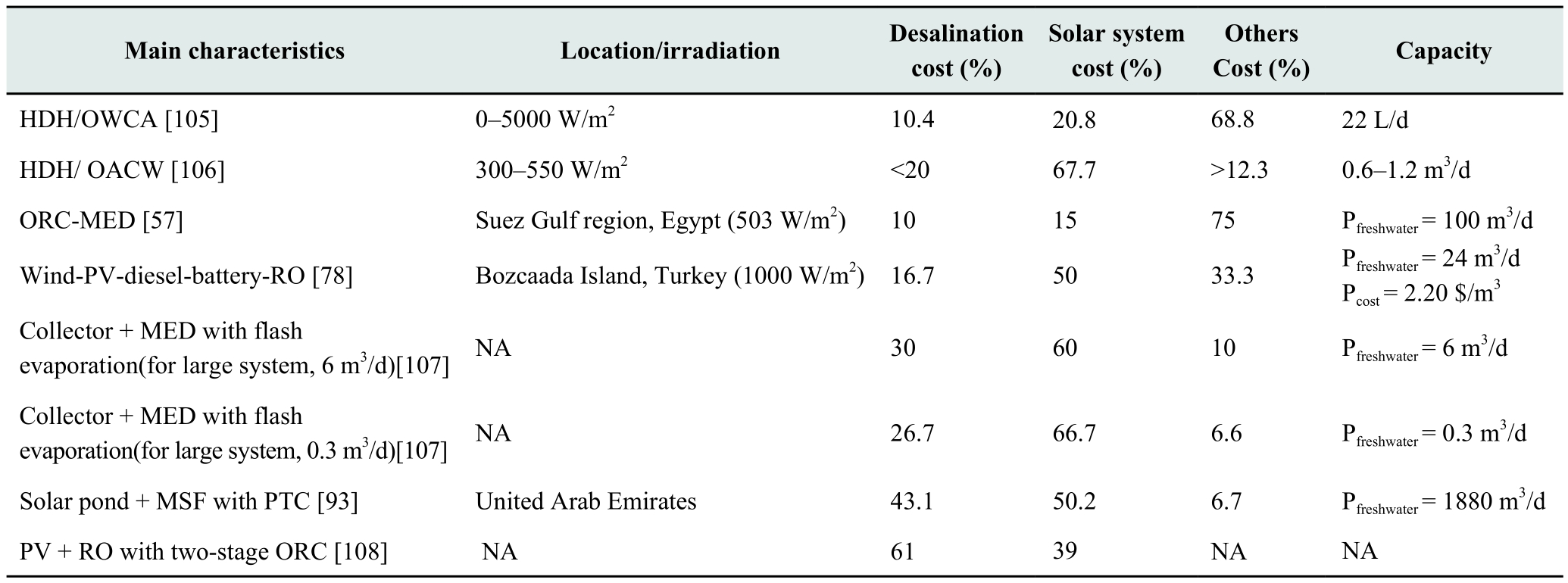
Table8 Comparison of different solar-powered desalination processes

In a solar-powered desalination system,solar radiation is either collected by a thermal collector (e.g.,MSF,MED,HDH,SC,and SD) or converted to electricity (e.g.,RO,ED,and MVC).Table8 compares some of the major solarpowered desalination processes.Solar thermal-driven desalination is very well-developed,while increasing focus is being given to PV cells.PV panels can easily be integrated with RO plants,which are a mature technology.Much research has recently been dedicated to the development of long-life membranes in relation to graphene and 2D membranes.The desalination cost is influenced by many factors,including the solar energy collector system,solar radiation,and desalination system energy transition efficiency.Research on low-cost solar desalination has generally been concentrated on SD and RO,which are suitable for small-scale water production and remote areas.For these solar desalination systems,solar/fossil/desalination hybrid systems can mitigate the intermittence of solar energy.
Table7 Solar-driven desalination system cost

Table8 Comparison of different solar-powered desalination processes

6 Outlook and conclusion
Historical data have shown that,although water scarcity is more serious in northern China,it has also emerged as a problem in some regions of southern China.High water consumption in the northern area is mainly concentrated in Tianjin,Hebei,Shandong,and other places with heavy industrial activity.In the south,most seawater desalination plants are on islands for civilian use and are mainly distributed in Zhejiang,Fujian,and Hainan.From a technical perspective,the thermal method provides stable and reliable operation and high water quality,but it has a high energy consumption.The membrane method has the advantages of low energy consumption,low capital costs,and greater operating flexibility,but the maintenance is high.
With regard to solar energy resources,China has an annual insolation of 1.39 × 1016 kWh.Provinces like the Qinghai-Tibet Plateau,northern Gansu,northern Ningxia,and southern Xinjiang receive the highest annual solar radiation in the world.Some portions of Liaoning,Tianjin,Shandong,Hebei,southwestern Shanxi,Jilin,southern Guangdong,southern Fujian,northern Jiangsu,and northern Anhui also receive fairly good amounts of annual radiation.Since Liaoning,Tianjin,Shandong,and Hebei receive the most radiation,they can harness the solar insolation with appropriate technology in the desalination sector to solve the water scarcity crisis faced by the country.
The 13th Five-Year Plan for the utilization of seawater proposes that,by 2020,the total scale of seawater desalination in China will reach more than 2.2 million tons/d.By the end of 2017,the seawater desalination scale was approximately 1.2 million tons/d,which is still 1 million tons/d short of the planning target.The Chinese government is moving towards the desalination application market and publishing relevant policy rules to accelerate desalination.
SWRO and LT-MED have generally been adopted in completed seawater desalination plants based on the characteristics of China's energy structure.MED is dominant in hydropower projects.Combined technologies(e.g.,MED+TVC or MED+RO),is also a development trend to complement technologies.Liaoning and Tianjin have built desalination plants with scales of 87,664 and 317,245 tons/d,respectively.In addition,Liaoning and Tianjin have sufficient solar energy resources of 1400-1700 and 1300-1500 (kWh/m2)/d,respectively.Solar-powered desalination engineering is highly feasible in Liaoning and Tianjin because of China's solar radiation distribution and desalination plant locations.
References
[1] Schiermeier Q (2008) Water:purification with a pinch of salt
[2] Darre NC,Toor GS (2018) Desalination of Water:a Review.Current Pollution Reports,4(2):104-111
[3] Semiat R (2008) Energy issues in desalination processes.Environmental science & technology,42(22):8193-8201
[4] Xu P,Cath TY,Robertson AP et al (2013) Critical review of desalination concentrate management,treatment and beneficial use.Environmental Engineering Science,30(8):502-14
[5] Trivedi HK,Upadhyay DB,Rana AH.Seawater Desalination Processes.
[6] Harandi HB,Rahnama M,Javaran EJ at al (2017) Performance optimization of a multi stage flash desalination unit with thermal vapor compression using genetic algorithm.Applied Thermal Engineering,Vol.123,pp:1106-1119
[7] Eveloy V,Rodgers P,Qiu L (2015) Hybrid gas turbine-organic Rankine cycle for seawater desalination by reverse osmosis in a hydrocarbon production facility.Energy Conversion and Management,Vol.106,pp:1134-1148
[8] Jiang S,Li Y,Ladewig BP (2017) A review of reverse osmosis membrane fouling and control strategies.Science of the Total Environment,Vol.595,pp:567-583
[9] Shemer H,Semiat R (2017) Sustainable RO desalination-Energy demand and environmental impact.Desalination,Vol.424,pp:10-16
[10] Eltawil MA,Zhao Z,Yuan L (2009) A review of renewable energy technologies integrated with desalination systems.Renewable and sustainable energy reviews,13(9):2245-2262
[11] Based on data from Ministry of Agriculture in China
[12] Based on cartographic data from Marine Strategic Planning and Economics,Ministry of Natural Resources,2017 National Seawater Utilization Report
[13] Delyannis E (2003) Historic background of desalination and renewable energies.Solar energy,75(5):357-366
[14] Darwish MA,Abdulrahim HK,Hassan AS et al (2015) PV and CSP solar technologies & desalination:economic analysis.Desalination & Water Treatment,pp:1-23
[15] Ali MT,Fath Hassan ES,Armstrong PR (2011) A comprehensive techno-economical review of indirect solar desalination.Renewable and Sustainable Energy Reviews,15(8):4187-4199
[16] Torkmahalleh MA,Askari M,Gorjinezhad S,et al (2017) Key factors impacting performance of a salinity gradient solar pond exposed to Mediterranean climate.Solar Energy,Vol.142,pp:321-329
[17] Sharon H,Reddy KS (2015) A review of solar energy driven desalination technologies.Renewable and Sustainable Energy Reviews,Vol.41,pp:1080-1118
[18] Fadaei N,Kasaeian A,Akbarzadeh A et al (2018) Experimental investigation of solar chimney with phase change material (PCM).Renewable Energy,Vol.123,pp:26-35
[19] Sangi R (2012) Performance evaluation of solar chimney power plants in Iran.Renewable and Sustainable Energy Reviews,16(1):704-710
[20] El-Haroun AA (2012) Performance evaluation of solar chimney power plants in Egypt.International Journal of Pure and Applied Sciences and Technology,13(2):49
[21] Hu S,Leung Dennis YC (2017) Mathematical modelling of the performance of a solar chimney power plant with divergent chimneys.Energy Procedia,Vol.110,pp:440-445
[22] Koonsrisuk A,Chitsomboon T (2013) Mathematical modeling of solar chimney power plants.Energy,Vol.51,pp:314-322
[23] Zhu L (2005) Study on achieving economic combined utilization of sea water by solar chimney technology.Tianjin University,China
[24] Zhou X,Xiao B,Liu W et al (2010) Comparison of classical solar chimney power system and combined solar chimney system for power generation and seawater desalination.Desalination,250(1):249-256
[25] Zuo L,Ding L,Chen J et al (2018) Comprehensive study of wind supercharged solar chimney power plant combined with seawater desalination.Solar Energy,Vol.166,pp:59-70
[26] Asayesh M,Kasaeian A,Ataei A (2017) Optimization of a combined solar chimney for desalination and power generation.Energy Conversion and Management,Vol.150,pp:72-80
[27] Kiwan S,Salam QIA (2018) Solar chimney power-water distillation plant (SCPWDP).Desalination,Vol.445,pp:105-114
[28] Zuo L,Zheng Y,Li Z et al (2011) Solar chimneys integrated with sea water desalination.Desalination,276(1-3):207-213
[29] Sharma SK,Sanghi R (2012) Wastewater reuse and management.Springer Science & Business Media,2012
[30] Tiwari GN,Dimri V,Chel A (2009) Parametric study of an active and passive solar distillation system:energy and exergy analysis.Desalination,242(1-3):1-18
[31] Rababa'h HM (2003) Experimental study of a solar still with sponge cubes in basin.Energy conversion and Management,44(9):1411-1418
[32] Omara ZM,Kabeel AE,Younes MM (2014) Enhancing the stepped solar still performance using internal and external reflectors.Energy conversion and management,Vol.78,pp:876-881
[33] Yeh HM,Chen LC (1987) Experimental studies on double-effect solar distiller.Energy,12(12):1251-6
[34] Xiong J,Xie G,Zheng H (2013) Experimental and numerical study on a new multieffect solar still with enhanced condensation surface.Energy Conversation and Management,Vol.73,pp:176-85
[35] Boukar M,Harmim A,Amar M (2011) Thermal behavior of a novelvertical solar still under desert climatic conditions.International Journal of Water Resources and Environmental Engineering,1(2):123-8
[36] Zheng H,Chang Z,Chen Z et al (2013) Experimental investigation and performance analysis on a group of multi-effect tubular solar desalination devices.Desalination,Vol.311,pp:62-68
[37] Omara ZM,Hamed MH,Kabeel AE (2011) Performance of finned and corrugated absorbers solar stills under Egyptian conditions.Desalination,Vol.277,pp:281-287
[38] Abdullah AS (2013) Improving the performance of stepped solar still.Desalination,Vol.319,pp:60-65
[39] Gugulothu R,Somanchi NS,Devi RSR et al (2015) Experimental investigations on performance evaluation of a single basin solar still using different energy absorbing materials.Aquatic Procedia,Vol.4,pp:1483-1491
[40] Chaichan MT,Kazem HA (2018) Single slope solar distillator productivity improvement using phase change material and Al2O3 nanoparticle.Solar Energy,Vol.164,pp:370-381
[41] Rajamanickam MR,Ragupathy A (2012) Influence of water depth on internal heat and mass transfer in a double slope solar still.Energy procedia,Vol.14,pp:1701-1708
[42] Mahdi JT,Smith BE,Sharif AO (2011) An experimental wicktype solar still system:design and construction.Desalination,267(2-3):233-238
[43] Setoodeh N,Rahimi R,Ameri A (2011) Modeling and determination of heat transfer coefficient in a basin solar still using CFD.Desalination,2011,268(1-3):103-110
[44] Gaw JS,Bhuyar LB (2013) Effect of Shape of the Absorber Surface on the Performance of Stepped Type Solar Still.2013
[45] Velmurugan V,Pandiarajan S,Guruparan P et al (2009)Integrated performance of stepped and single basin solar stills with mini solar pond.Desalination,249(3):902-909
[46] Abdallah S,Badran OO (2008) Sun tracking system for productivity enhancement of solar still.Desalination,220(1-3),669-676
[47] Kumar S,Tiwari GN (2009) Life cycle cost analysis of single slope hybrid (PV/T) active solar still.Applied Energy,86(10):1995-2004
[48] Arunkumar T,Kabeel AE,Raj K et al (2018) Productivity enhancement of solar still by using porous absorber with bubblewrap insulation.Journal of Cleaner Production,2018
[49] Murugavel KK,Srithar K (2011) Performance study on basin type double slope solar still with different wick materials and minimum mass of water.Renewable Energy,36(2):612-620
[50] El-Sebaii AA,Ramadan MRI,Aboul-Enein S et al (2015)Effect of fin configuration parameters on single basin solar still performance.Desalination,Vol.365,pp:15-24
[51] Elimelech M,Phillip WA (2011) The future of seawater desalination:energy,technology,and the environment.science,333(6043):712-717
[52] Al-Shammiri M,Safar M (1999) Multi-effect distillation plants:state of the art.Desalination,126(1):45-59
[53] Shahzad MW,Ng KC,Thu K et al (2014) Multi effect desalination and adsorption desalination (MEDAD):A hybrid desalination method.Applied Thermal Engineering,72(2):289-297
[54] Carballo JA,Bonilla J,Roca L et al (2018) Optimal operating conditions analysis for a multi-effect distillation plant according to energetic and exergetic criteria.Desalination Vol.435,pp:70-76
[55] Frantz C,Seifert B (2015) Thermal analysis of a multi effect distillation plant powered by a solar tower plant.Energy Procedia,Vol.69,pp:1928-1937
[56] Alarcón-Padilla DC,García-Rodríguez L,Blanco-Gálvez J(2010) Design recommendations for a multi-effect distillation plant connected to a double-effect absorption heat pump:A solar desalination case study.Desalination,262(1-3):11-14
[57] Sharaf MA,Nafey AS,García-Rodríguez L (2011) Exergy and thermo-economic analyses of a combined solar organic cycle with multi effect distillation (MED) desalination process.Desalination,272(1-3):135-147
[58] Bataineh KM (2016) Multi-effect desalination plant combined with thermal compressor driven by steam generated by solar energy.Desalination,Vol.385,pp:39-52
[59] Ortega-Delgado B,Palenzuela P,Alarcón-Padilla DC (2016)Parametric study of a multi-effect distillation plant with thermal vapor compression for its integration into a Rankine cycle power block.Desalination,Vol.394,pp:18-29
[60] Childs WD,Dabiri AE,Al-Hinai HA et al (1999) VARI-RO solar-powered desalting technology.Desalination,Vol.125,pp:155-166
[61] Greenlee LF,Lawler DF,Freeman BD et al (2009) Reverse osmosis desalination:water sources,technology,and today's challenges.Water Research,Vol.43,pp:2317-2348
[62] Abdallah S,Abu-Hilal M,Mohsen MS (2005) Performance of a photovoltaic powered reverse osmosis system under local climatic conditions.Desalination,Vol.183,pp:95-104
[63] Caldera U,Bogdanov D,Breyer C (2016) Local cost of seawater RO desalination based on solar PV and wind energy:A global estimate.Desalination,Vol.385,pp:207-216
[64] Alkaisi A,Mossad R,Sharifian-Barforoush A (2017) A review of the water desalination systems integrated with renewable energy.Energy Procedia,Vol.110,pp:268-274
[65] Gocht W,Sommerfeld A,Rautenbach R et al (1998)Decentralized desalination of brackish water by a directly coupled reverse osmosis photovoltaic system - a pilot plant study in Jordan.Renewable Energy,14(1-4):287-292
[66] Nafey AS,Sharaf MA (2010) Combined solar organic Rankine cycle with reverse osmosis desalination process:energy,exergy,and cost evaluations.Renewable Energy,35(11):2571-2580
[67] Manolakos D,Kosmadakis G,Kyritsis S et al (2009) On site experimental evaluation of a low-temperature solar organic Rankine cycle system for RO desalination.Solar Energy,83(5):646-656
[68] Mahmoudi A,Fazli M,Morad MR (2018) A recent review of waste heat recovery by Organic Rankine Cycle.Applied Thermal Engineering,2018
[69] Attia AAA (2012) Thermal analysis for system uses solar energy as a pressure source for reverse osmosis (RO) water desalination.Solar Energy,86(9):2486-2493
[70] Alghoul MA,Poovanaesvaran P,Mohammed MH et al (2016)Design and experimental performance of brackish water reverse osmosis desalination unit powered by 2 kW photovoltaic system.Renewable Energy,Vol.93,pp:101-114
[71] Bilton AM,Wiesman R,Arif AFM et al (2011) On the feasibility of community-scale photovoltaic-powered reverse osmosis desalination systems for remote locations.Renewable Energy,36(12):3246-3256
[72] Greenlee LF,Lawler DF,Freeman BD et al (2009) Reverse osmosis desalination:water sources,technology,and today's challenges.Water Research,Vol.43,pp:2317-2348
[73] Bilton AM,Wiesman R,Arif AFM et al (2011) On the feasibility of community-scale photovoltaic-powered reverse osmosis desalination systems for remote locations.Renewable Energy,36(12):3246-3256
[74] Manolakos D,Mohamed ES,Karagiannis I et al (2008) Technical and economic comparison between PV-RO system and RO-Solar Rankine system.Case study:Thirasia island.Desalination,221(1-3):37-46
[75] Cherif H,Belhadj J (2011) Large-scale time evaluation for energy estimation of stand-alone hybrid photovoltaic-wind system feeding a reverse osmosis desalination unit.Energy,36(10):6058-6067
[76] Kelley LC,Dubowsky S (2013) Thermal control to maximize photovoltaic powered reverse osmosis desalination systems productivity.Desalination,Vol.314,pp:10-19
[77] Ahmad N,Sheikh AK,Gandhidasan P et al (2015) Modeling,simulation and performance evaluation of a community scale PVRO water desalination system operated by fixed and tracking PV panels:A case study for Dhahran city,Saudi Arabia.Renewable Energy,Vol.75,pp:433-447
[78] Gökçek M (2018) Integration of hybrid power (windphotovoltaic-diesel-battery) and seawater reverse osmosis systems for small-scale desalination applications.Desalination,Vol.435,pp:210-220
[79] Tabor H (1981) Solar ponds.Solar energy,27(3):181-194
[80] Alcaraz A,Valderrama C,Cortina JL et al (2016) Enhancing the efficiency of solar pond heat extraction by using both lateral and bottom heat exchangers.Solar energy,Vol.134,pp:82-94
[81] Kasaeian A,Sharifi S,Yan WM (2018) Novel achievements in the development of solar ponds:A review.Solar Energy,Vol.174,pp:189-206
[82] Bozkurt I,Karakilcik M (2012) The daily performance of a solar pond integrated with solar collectors.Solar Energy,86(5):1611-1620
[83] Tundee S,Terdtoon P,Sakulchangsatjatai P et al (2010) Heat extraction from salinity-gradient solar ponds using heat pipe heat exchangers.Solar Energy,84(9):1706-1716
[84] Alcaraz A,Montalà M,Cortina JL et al (2018) Design,construction,and operation of the first industrial salinity-gradient solar pond in Europe:An efficiency analysis perspective.Solar Energy,Vol.164,pp:316-326
[85] El-Sebaii AA,Ramadan MRI,Aboul-Enein S et al (2011) History of the solar ponds:a review study.Renewable and Sustainable Energy Reviews,15(6):3319-3325
[86] Date A,Yaakob Y,Date A et al (2013) Heat extraction from non-convective and lower convective zones of the solar pond:a transient study.Solar Energy,Vol.97,pp:517-528
[87] Abdulsalam A,Idris AA.Mohamed T et al (2015) The development and applications of solar pond:a review.Desalination and Water Treatment,53(9):2437-2449
[88] Ranjan KR,Kaushik SC (2014) Thermodynamic and economic feasibility of solar ponds for various thermal applications:A comprehensive review.Renewable and Sustainable Energy Reviews,Vol.32,pp:123-139
[89] Sayer AH,Al-Hussaini H,Campbell AN (2018) New comprehensive investigation on the feasibility of the gel solar pond,and a comparison with the salinity gradient solar pond.Applied Thermal Engineering,Vol.130,pp:672-683
[90] Gude VG (2015) Energy storage for desalination processes powered by renewable energy and waste heat sources.Applied Energy,Vol.137,pp:877-898
[91] Posnansky M (1987) Technical and economical aspects of solar desalination with particular emphasis on solar pond powered distillation plants.Desalination,67(none):81-95
[92] Agha KR (2009) The thermal characteristics and economic analysis of a solar pond coupled low temperature multi stage desalination plant.Solar Energy,83(4):501-510
[93] Al-Othman A,Tawalbeh M,Assad MEH et al (2018) Novel multi-stage flash (MSF) desalination plant driven by parabolic trough collectors and a solar pond:A simulation study in UAE.Desalination,Vol.443,pp:237-244
[94] Leblanc J,Andrews J (2007) Low-Temperature Multi-Effect Evaporation Desalination Systems Coupled with Salinity-Gradient Solar Ponds.In:Proceedings of ISES World Congress 2007 (Vol.I - Vol.V),pp:2151-2157
[95] Leblanc J,Andrews J,Akbarzadeh A (2010) Low-temperature solar-thermal multi-effect evaporation desalination systems.International Journal of Energy Research,34(5):393-403
[96] Caruso G,Naviglio A,Principi P et al (2001) High-energy efficiency desalination project using a full titanium desalination unit and a solar pond as the heat supply.Desalination,136(1-3):199-212
[97] El-Sebaii AA,Aboul-Enein S,Ramadan MRI et al (2011)Thermal performance of an active single basin solar still (ASBS)coupled to shallow solar pond (SSP).Desalination,280(1-3):183-190
[98] Suárez F,Urtubia R (2016) Tackling the water-energy nexus:an assessment of membrane distillation driven by salt-gradient solar ponds.Clean Technologies and Environmental Policy,18(6):1697-1712
[99] Suárez F,Ruskowitz JA,Tyler SW et al (2015) Renewable water:direct contact membrane distillation coupled with solar ponds.Applied energy,Vol.158,pp:532-539
[100] Suárez F,Aravena JE,Hausner MB et al (2011).Assessment of a vertical high-resolution distributed-temperature-sensing system in a shallow thermohaline environment.Hydrology and Earth System Sciences,15(3):1081-1093
[101] Nakoa K,Rahaoui K,Date A et al (2015) An experimental review on coupling of solar pond with membrane distillation.Solar Energy,Vol.119,pp:319-331
[102] Akbarzadeh A,Johnson P,Singh R (2009) Examining potential benefits of combining a chimney with a salinity gradient solar pond for production of power in salt affected areas.Solar Energy,83(8):1345-1359
[103] Monjezi AA,Mahood HB,Campbell AN (2017) Regeneration of dimethyl ether as a draw solute in forward osmosis by utilising thermal energy from a solar pond.Desalination,Vol.415,pp:104-114
[104] Trieb F,Müller-Steinhagen H (2008) Concentrating solar power for seawater desalination in the Middle East and North Africa.Desalination,220(1-3):165-183
[105] Hamed MH,Kabeel AE,Omara ZM et al (2015) Mathematical and experimental investigation of a solar humidificationdehumidification desalination unit.Desalination,Vol.358,pp:9-17
[106] Yuan G,Wang Z,Li H et al (2011) Experimental study of a solar desalination system based on humidification-dehumidification process.Desalination,277(1-3):92-98
[107] Jiang J,Tian H,Cui M et al (2009) Proof-of-concept study of an integrated solar desalination system.Renewable Energy,34(12):2798-2802
[108] Kosmadakis G,Manolakos D,Kyritsis S et al (2009) Economic assessment of a two-stage solar organic Rankine cycle for reverse osmosis desalination.Renewable Energy,34(6):1579-1586
[109] Li C,Goswami Y,Stefanakos E (2013) Solar assisted sea water desalination:A review.Renewable and Sustainable Energy Reviews,Vol.19,pp:136-163
[110] Sharaf MA,Nafey AS,Lourdes García-Rodríguez (2011)Exergy and thermo-economic analyses of a combined solar organic cycle with multi effect distillation (MED) desalination process.Desalination,272(1-3):135-147
[111] Al-Karaghouli A,Kazmerski LL (2013) Energy consumption and water production cost of conventional and renewableenergy-powered desalination processes.Renewable and Sustainable Energy Reviews,Vol.24,pp:343-356

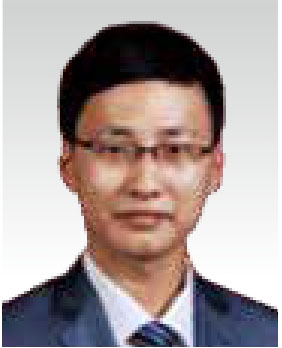


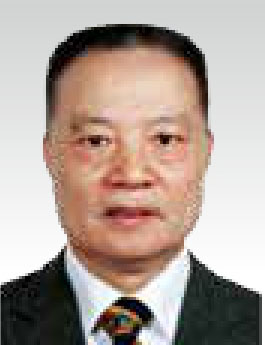
Historical data have shown that,although water scarcity is more serious in northern China,it has also emerged as a problem in some regions of southern China.High water consumption in the northern area is mainly concentrated in Tianjin,Hebei,Shandong,and other places with heavy industrial activity.In the south,most seawater desalination plants are on islands for civilian use and are mainly distributed in Zhejiang,Fujian,and Hainan.From a technical perspective,the thermal method provides stable and reliable operation and high water quality,but it has a high energy consumption.The membrane method has the advantages of low energy consumption,low capital costs,and greater operating flexibility,but the maintenance is high.
With regard to solar energy resources,China has an annual insolation of 1.39 × 1016 kWh.Provinces like the Qinghai-Tibet Plateau,northern Gansu,northern Ningxia,and southern Xinjiang receive the highest annual solar radiation in the world.Some portions of Liaoning,Tianjin,Shandong,Hebei,southwestern Shanxi,Jilin,southern Guangdong,southern Fujian,northern Jiangsu,and northern Anhui also receive fairly good amounts of annual radiation.Since Liaoning,Tianjin,Shandong,and Hebei receive the most radiation,they can harness the solar insolation with appropriate technology in the desalination sector to solve the water scarcity crisis faced by the country.
The 13th Five-Year Plan for the utilization of seawater proposes that,by 2020,the total scale of seawater desalination in China will reach more than 2.2 million tons/d.By the end of 2017,the seawater desalination scale was approximately 1.2 million tons/d,which is still 1 million tons/d short of the planning target.The Chinese government is moving towards the desalination application market and publishing relevant policy rules to accelerate desalination.
SWRO and LT-MED have generally been adopted in completed seawater desalination plants based on the characteristics of China's energy structure.MED is dominant in hydropower projects.Combined technologies(e.g.,MED+TVC or MED+RO),is also a development trend to complement technologies.Liaoning and Tianjin have built desalination plants with scales of 87,664 and 317,245 tons/d,respectively.In addition,Liaoning and Tianjin have sufficient solar energy resources of 1400-1700 and 1300-1500 (kWh/m2)/d,respectively.Solar-powered desalination engineering is highly feasible in Liaoning and Tianjin because of China's solar radiation distribution and desalination plant locations.
References
[1] Schiermeier Q (2008) Water:purification with a pinch of salt
[2] Darre NC,Toor GS (2018) Desalination of Water:a Review.Current Pollution Reports,4(2):104-111
[3] Semiat R (2008) Energy issues in desalination processes.Environmental science & technology,42(22):8193-8201
[4] Xu P,Cath TY,Robertson AP et al (2013) Critical review of desalination concentrate management,treatment and beneficial use.Environmental Engineering Science,30(8):502-14
[5] Trivedi HK,Upadhyay DB,Rana AH.Seawater Desalination Processes.
[6] Harandi HB,Rahnama M,Javaran EJ at al (2017) Performance optimization of a multi stage flash desalination unit with thermal vapor compression using genetic algorithm.Applied Thermal Engineering,Vol.123,pp:1106-1119
[7] Eveloy V,Rodgers P,Qiu L (2015) Hybrid gas turbine-organic Rankine cycle for seawater desalination by reverse osmosis in a hydrocarbon production facility.Energy Conversion and Management,Vol.106,pp:1134-1148
[8] Jiang S,Li Y,Ladewig BP (2017) A review of reverse osmosis membrane fouling and control strategies.Science of the Total Environment,Vol.595,pp:567-583
[9] Shemer H,Semiat R (2017) Sustainable RO desalination-Energy demand and environmental impact.Desalination,Vol.424,pp:10-16
[10] Eltawil MA,Zhao Z,Yuan L (2009) A review of renewable energy technologies integrated with desalination systems.Renewable and sustainable energy reviews,13(9):2245-2262
[11] Based on data from Ministry of Agriculture in China
[12] Based on cartographic data from Marine Strategic Planning and Economics,Ministry of Natural Resources,2017 National Seawater Utilization Report
[13] Delyannis E (2003) Historic background of desalination and renewable energies.Solar energy,75(5):357-366
[14] Darwish MA,Abdulrahim HK,Hassan AS et al (2015) PV and CSP solar technologies & desalination:economic analysis.Desalination & Water Treatment,pp:1-23
[15] Ali MT,Fath Hassan ES,Armstrong PR (2011) A comprehensive techno-economical review of indirect solar desalination.Renewable and Sustainable Energy Reviews,15(8):4187-4199
[16] Torkmahalleh MA,Askari M,Gorjinezhad S,et al (2017) Key factors impacting performance of a salinity gradient solar pond exposed to Mediterranean climate.Solar Energy,Vol.142,pp:321-329
[17] Sharon H,Reddy KS (2015) A review of solar energy driven desalination technologies.Renewable and Sustainable Energy Reviews,Vol.41,pp:1080-1118
[18] Fadaei N,Kasaeian A,Akbarzadeh A et al (2018) Experimental investigation of solar chimney with phase change material (PCM).Renewable Energy,Vol.123,pp:26-35
[19] Sangi R (2012) Performance evaluation of solar chimney power plants in Iran.Renewable and Sustainable Energy Reviews,16(1):704-710
[20] El-Haroun AA (2012) Performance evaluation of solar chimney power plants in Egypt.International Journal of Pure and Applied Sciences and Technology,13(2):49
[21] Hu S,Leung Dennis YC (2017) Mathematical modelling of the performance of a solar chimney power plant with divergent chimneys.Energy Procedia,Vol.110,pp:440-445
[22] Koonsrisuk A,Chitsomboon T (2013) Mathematical modeling of solar chimney power plants.Energy,Vol.51,pp:314-322
[23] Zhu L (2005) Study on achieving economic combined utilization of sea water by solar chimney technology.Tianjin University,China
[24] Zhou X,Xiao B,Liu W et al (2010) Comparison of classical solar chimney power system and combined solar chimney system for power generation and seawater desalination.Desalination,250(1):249-256
[25] Zuo L,Ding L,Chen J et al (2018) Comprehensive study of wind supercharged solar chimney power plant combined with seawater desalination.Solar Energy,Vol.166,pp:59-70
[26] Asayesh M,Kasaeian A,Ataei A (2017) Optimization of a combined solar chimney for desalination and power generation.Energy Conversion and Management,Vol.150,pp:72-80
[27] Kiwan S,Salam QIA (2018) Solar chimney power-water distillation plant (SCPWDP).Desalination,Vol.445,pp:105-114
[28] Zuo L,Zheng Y,Li Z et al (2011) Solar chimneys integrated with sea water desalination.Desalination,276(1-3):207-213
[29] Sharma SK,Sanghi R (2012) Wastewater reuse and management.Springer Science & Business Media,2012
[30] Tiwari GN,Dimri V,Chel A (2009) Parametric study of an active and passive solar distillation system:energy and exergy analysis.Desalination,242(1-3):1-18
[31] Rababa'h HM (2003) Experimental study of a solar still with sponge cubes in basin.Energy conversion and Management,44(9):1411-1418
[32] Omara ZM,Kabeel AE,Younes MM (2014) Enhancing the stepped solar still performance using internal and external reflectors.Energy conversion and management,Vol.78,pp:876-881
[33] Yeh HM,Chen LC (1987) Experimental studies on double-effect solar distiller.Energy,12(12):1251-6
[34] Xiong J,Xie G,Zheng H (2013) Experimental and numerical study on a new multieffect solar still with enhanced condensation surface.Energy Conversation and Management,Vol.73,pp:176-85
[35] Boukar M,Harmim A,Amar M (2011) Thermal behavior of a novelvertical solar still under desert climatic conditions.International Journal of Water Resources and Environmental Engineering,1(2):123-8
[36] Zheng H,Chang Z,Chen Z et al (2013) Experimental investigation and performance analysis on a group of multi-effect tubular solar desalination devices.Desalination,Vol.311,pp:62-68
[37] Omara ZM,Hamed MH,Kabeel AE (2011) Performance of finned and corrugated absorbers solar stills under Egyptian conditions.Desalination,Vol.277,pp:281-287
[38] Abdullah AS (2013) Improving the performance of stepped solar still.Desalination,Vol.319,pp:60-65
[39] Gugulothu R,Somanchi NS,Devi RSR et al (2015) Experimental investigations on performance evaluation of a single basin solar still using different energy absorbing materials.Aquatic Procedia,Vol.4,pp:1483-1491
[40] Chaichan MT,Kazem HA (2018) Single slope solar distillator productivity improvement using phase change material and Al2O3 nanoparticle.Solar Energy,Vol.164,pp:370-381
[41] Rajamanickam MR,Ragupathy A (2012) Influence of water depth on internal heat and mass transfer in a double slope solar still.Energy procedia,Vol.14,pp:1701-1708
[42] Mahdi JT,Smith BE,Sharif AO (2011) An experimental wicktype solar still system:design and construction.Desalination,267(2-3):233-238
[43] Setoodeh N,Rahimi R,Ameri A (2011) Modeling and determination of heat transfer coefficient in a basin solar still using CFD.Desalination,2011,268(1-3):103-110
[44] Gaw JS,Bhuyar LB (2013) Effect of Shape of the Absorber Surface on the Performance of Stepped Type Solar Still.2013
[45] Velmurugan V,Pandiarajan S,Guruparan P et al (2009)Integrated performance of stepped and single basin solar stills with mini solar pond.Desalination,249(3):902-909
[46] Abdallah S,Badran OO (2008) Sun tracking system for productivity enhancement of solar still.Desalination,220(1-3),669-676
[47] Kumar S,Tiwari GN (2009) Life cycle cost analysis of single slope hybrid (PV/T) active solar still.Applied Energy,86(10):1995-2004
[48] Arunkumar T,Kabeel AE,Raj K et al (2018) Productivity enhancement of solar still by using porous absorber with bubblewrap insulation.Journal of Cleaner Production,2018
[49] Murugavel KK,Srithar K (2011) Performance study on basin type double slope solar still with different wick materials and minimum mass of water.Renewable Energy,36(2):612-620
[50] El-Sebaii AA,Ramadan MRI,Aboul-Enein S et al (2015)Effect of fin configuration parameters on single basin solar still performance.Desalination,Vol.365,pp:15-24
[51] Elimelech M,Phillip WA (2011) The future of seawater desalination:energy,technology,and the environment.science,333(6043):712-717
[52] Al-Shammiri M,Safar M (1999) Multi-effect distillation plants:state of the art.Desalination,126(1):45-59
[53] Shahzad MW,Ng KC,Thu K et al (2014) Multi effect desalination and adsorption desalination (MEDAD):A hybrid desalination method.Applied Thermal Engineering,72(2):289-297
[54] Carballo JA,Bonilla J,Roca L et al (2018) Optimal operating conditions analysis for a multi-effect distillation plant according to energetic and exergetic criteria.Desalination Vol.435,pp:70-76
[55] Frantz C,Seifert B (2015) Thermal analysis of a multi effect distillation plant powered by a solar tower plant.Energy Procedia,Vol.69,pp:1928-1937
[56] Alarcón-Padilla DC,García-Rodríguez L,Blanco-Gálvez J(2010) Design recommendations for a multi-effect distillation plant connected to a double-effect absorption heat pump:A solar desalination case study.Desalination,262(1-3):11-14
[57] Sharaf MA,Nafey AS,García-Rodríguez L (2011) Exergy and thermo-economic analyses of a combined solar organic cycle with multi effect distillation (MED) desalination process.Desalination,272(1-3):135-147
[58] Bataineh KM (2016) Multi-effect desalination plant combined with thermal compressor driven by steam generated by solar energy.Desalination,Vol.385,pp:39-52
[59] Ortega-Delgado B,Palenzuela P,Alarcón-Padilla DC (2016)Parametric study of a multi-effect distillation plant with thermal vapor compression for its integration into a Rankine cycle power block.Desalination,Vol.394,pp:18-29
[60] Childs WD,Dabiri AE,Al-Hinai HA et al (1999) VARI-RO solar-powered desalting technology.Desalination,Vol.125,pp:155-166
[61] Greenlee LF,Lawler DF,Freeman BD et al (2009) Reverse osmosis desalination:water sources,technology,and today's challenges.Water Research,Vol.43,pp:2317-2348
[62] Abdallah S,Abu-Hilal M,Mohsen MS (2005) Performance of a photovoltaic powered reverse osmosis system under local climatic conditions.Desalination,Vol.183,pp:95-104
[63] Caldera U,Bogdanov D,Breyer C (2016) Local cost of seawater RO desalination based on solar PV and wind energy:A global estimate.Desalination,Vol.385,pp:207-216
[64] Alkaisi A,Mossad R,Sharifian-Barforoush A (2017) A review of the water desalination systems integrated with renewable energy.Energy Procedia,Vol.110,pp:268-274
[65] Gocht W,Sommerfeld A,Rautenbach R et al (1998)Decentralized desalination of brackish water by a directly coupled reverse osmosis photovoltaic system - a pilot plant study in Jordan.Renewable Energy,14(1-4):287-292
[66] Nafey AS,Sharaf MA (2010) Combined solar organic Rankine cycle with reverse osmosis desalination process:energy,exergy,and cost evaluations.Renewable Energy,35(11):2571-2580
[67] Manolakos D,Kosmadakis G,Kyritsis S et al (2009) On site experimental evaluation of a low-temperature solar organic Rankine cycle system for RO desalination.Solar Energy,83(5):646-656
[68] Mahmoudi A,Fazli M,Morad MR (2018) A recent review of waste heat recovery by Organic Rankine Cycle.Applied Thermal Engineering,2018
[69] Attia AAA (2012) Thermal analysis for system uses solar energy as a pressure source for reverse osmosis (RO) water desalination.Solar Energy,86(9):2486-2493
[70] Alghoul MA,Poovanaesvaran P,Mohammed MH et al (2016)Design and experimental performance of brackish water reverse osmosis desalination unit powered by 2 kW photovoltaic system.Renewable Energy,Vol.93,pp:101-114
[71] Bilton AM,Wiesman R,Arif AFM et al (2011) On the feasibility of community-scale photovoltaic-powered reverse osmosis desalination systems for remote locations.Renewable Energy,36(12):3246-3256
[72] Greenlee LF,Lawler DF,Freeman BD et al (2009) Reverse osmosis desalination:water sources,technology,and today's challenges.Water Research,Vol.43,pp:2317-2348
[73] Bilton AM,Wiesman R,Arif AFM et al (2011) On the feasibility of community-scale photovoltaic-powered reverse osmosis desalination systems for remote locations.Renewable Energy,36(12):3246-3256
[74] Manolakos D,Mohamed ES,Karagiannis I et al (2008) Technical and economic comparison between PV-RO system and RO-Solar Rankine system.Case study:Thirasia island.Desalination,221(1-3):37-46
[75] Cherif H,Belhadj J (2011) Large-scale time evaluation for energy estimation of stand-alone hybrid photovoltaic-wind system feeding a reverse osmosis desalination unit.Energy,36(10):6058-6067
[76] Kelley LC,Dubowsky S (2013) Thermal control to maximize photovoltaic powered reverse osmosis desalination systems productivity.Desalination,Vol.314,pp:10-19
[77] Ahmad N,Sheikh AK,Gandhidasan P et al (2015) Modeling,simulation and performance evaluation of a community scale PVRO water desalination system operated by fixed and tracking PV panels:A case study for Dhahran city,Saudi Arabia.Renewable Energy,Vol.75,pp:433-447
[78] Gökçek M (2018) Integration of hybrid power (windphotovoltaic-diesel-battery) and seawater reverse osmosis systems for small-scale desalination applications.Desalination,Vol.435,pp:210-220
[79] Tabor H (1981) Solar ponds.Solar energy,27(3):181-194
[80] Alcaraz A,Valderrama C,Cortina JL et al (2016) Enhancing the efficiency of solar pond heat extraction by using both lateral and bottom heat exchangers.Solar energy,Vol.134,pp:82-94
[81] Kasaeian A,Sharifi S,Yan WM (2018) Novel achievements in the development of solar ponds:A review.Solar Energy,Vol.174,pp:189-206
[82] Bozkurt I,Karakilcik M (2012) The daily performance of a solar pond integrated with solar collectors.Solar Energy,86(5):1611-1620
[83] Tundee S,Terdtoon P,Sakulchangsatjatai P et al (2010) Heat extraction from salinity-gradient solar ponds using heat pipe heat exchangers.Solar Energy,84(9):1706-1716
[84] Alcaraz A,Montalà M,Cortina JL et al (2018) Design,construction,and operation of the first industrial salinity-gradient solar pond in Europe:An efficiency analysis perspective.Solar Energy,Vol.164,pp:316-326
[85] El-Sebaii AA,Ramadan MRI,Aboul-Enein S et al (2011) History of the solar ponds:a review study.Renewable and Sustainable Energy Reviews,15(6):3319-3325
[86] Date A,Yaakob Y,Date A et al (2013) Heat extraction from non-convective and lower convective zones of the solar pond:a transient study.Solar Energy,Vol.97,pp:517-528
[87] Abdulsalam A,Idris AA.Mohamed T et al (2015) The development and applications of solar pond:a review.Desalination and Water Treatment,53(9):2437-2449
[88] Ranjan KR,Kaushik SC (2014) Thermodynamic and economic feasibility of solar ponds for various thermal applications:A comprehensive review.Renewable and Sustainable Energy Reviews,Vol.32,pp:123-139
[89] Sayer AH,Al-Hussaini H,Campbell AN (2018) New comprehensive investigation on the feasibility of the gel solar pond,and a comparison with the salinity gradient solar pond.Applied Thermal Engineering,Vol.130,pp:672-683
[90] Gude VG (2015) Energy storage for desalination processes powered by renewable energy and waste heat sources.Applied Energy,Vol.137,pp:877-898
[91] Posnansky M (1987) Technical and economical aspects of solar desalination with particular emphasis on solar pond powered distillation plants.Desalination,67(none):81-95
[92] Agha KR (2009) The thermal characteristics and economic analysis of a solar pond coupled low temperature multi stage desalination plant.Solar Energy,83(4):501-510
[93] Al-Othman A,Tawalbeh M,Assad MEH et al (2018) Novel multi-stage flash (MSF) desalination plant driven by parabolic trough collectors and a solar pond:A simulation study in UAE.Desalination,Vol.443,pp:237-244
[94] Leblanc J,Andrews J (2007) Low-Temperature Multi-Effect Evaporation Desalination Systems Coupled with Salinity-Gradient Solar Ponds.In:Proceedings of ISES World Congress 2007 (Vol.I - Vol.V),pp:2151-2157
[95] Leblanc J,Andrews J,Akbarzadeh A (2010) Low-temperature solar-thermal multi-effect evaporation desalination systems.International Journal of Energy Research,34(5):393-403
[96] Caruso G,Naviglio A,Principi P et al (2001) High-energy efficiency desalination project using a full titanium desalination unit and a solar pond as the heat supply.Desalination,136(1-3):199-212
[97] El-Sebaii AA,Aboul-Enein S,Ramadan MRI et al (2011)Thermal performance of an active single basin solar still (ASBS)coupled to shallow solar pond (SSP).Desalination,280(1-3):183-190
[98] Suárez F,Urtubia R (2016) Tackling the water-energy nexus:an assessment of membrane distillation driven by salt-gradient solar ponds.Clean Technologies and Environmental Policy,18(6):1697-1712
[99] Suárez F,Ruskowitz JA,Tyler SW et al (2015) Renewable water:direct contact membrane distillation coupled with solar ponds.Applied energy,Vol.158,pp:532-539
[100] Suárez F,Aravena JE,Hausner MB et al (2011).Assessment of a vertical high-resolution distributed-temperature-sensing system in a shallow thermohaline environment.Hydrology and Earth System Sciences,15(3):1081-1093
[101] Nakoa K,Rahaoui K,Date A et al (2015) An experimental review on coupling of solar pond with membrane distillation.Solar Energy,Vol.119,pp:319-331
[102] Akbarzadeh A,Johnson P,Singh R (2009) Examining potential benefits of combining a chimney with a salinity gradient solar pond for production of power in salt affected areas.Solar Energy,83(8):1345-1359
[103] Monjezi AA,Mahood HB,Campbell AN (2017) Regeneration of dimethyl ether as a draw solute in forward osmosis by utilising thermal energy from a solar pond.Desalination,Vol.415,pp:104-114
[104] Trieb F,Müller-Steinhagen H (2008) Concentrating solar power for seawater desalination in the Middle East and North Africa.Desalination,220(1-3):165-183
[105] Hamed MH,Kabeel AE,Omara ZM et al (2015) Mathematical and experimental investigation of a solar humidificationdehumidification desalination unit.Desalination,Vol.358,pp:9-17
[106] Yuan G,Wang Z,Li H et al (2011) Experimental study of a solar desalination system based on humidification-dehumidification process.Desalination,277(1-3):92-98
[107] Jiang J,Tian H,Cui M et al (2009) Proof-of-concept study of an integrated solar desalination system.Renewable Energy,34(12):2798-2802
[108] Kosmadakis G,Manolakos D,Kyritsis S et al (2009) Economic assessment of a two-stage solar organic Rankine cycle for reverse osmosis desalination.Renewable Energy,34(6):1579-1586
[109] Li C,Goswami Y,Stefanakos E (2013) Solar assisted sea water desalination:A review.Renewable and Sustainable Energy Reviews,Vol.19,pp:136-163
[110] Sharaf MA,Nafey AS,Lourdes García-Rodríguez (2011)Exergy and thermo-economic analyses of a combined solar organic cycle with multi effect distillation (MED) desalination process.Desalination,272(1-3):135-147
[111] Al-Karaghouli A,Kazmerski LL (2013) Energy consumption and water production cost of conventional and renewableenergy-powered desalination processes.Renewable and Sustainable Energy Reviews,Vol.24,pp:343-356






Scan for more details
Received:12 March 2019/Accepted:15 March 2019/Published:25 April 2019
Chao Chen
charleschen@mail.bnu.edu.cn
Yilin Jiang
jiangyilin@mail.bnu.edu.cn
Zhaoyong Ye
yezhaoyong123@126.com
Yu Yang
yangyu@bnu.edu.cn
Li'an Hou
houlian678@hotmail.com
2096-5117/©2019 Global Energy Interconnection Development and Cooperation Organization.Production and hosting by Elsevier B.V.on behalf of KeAi Communications Co.,Ltd.This is an open access article under the CC BY-NC-ND license (http://creativecommons.org/licenses/by-nc-nd/4.0/).
Acknowledgements
This work was supported by the state Grid Science and Technology Project (No.52450018000F,Title:Synergistic Development Theory and Key Technology Research of Seawater Deslination and Clean Energy).
Biographies
Chao Chen received his bachelor degree in environmental engineering from Hubei normal university,China in 2016.He is working towards the Ph.D.degree in environmental engineering at Beijing Normal University,China.His research interests include membrane potable water treatment technology,desalination and comprehensive utilization of seawater.
Zhaoyong Ye received his master degree from Northeast Electric Power University in 2017.He is working towards the Ph.D.degree in the School of Environment,Beijing Normal University.His research interests include water treatment technology,modified membrane preparation,desalination treatment,and radionuclides removal technology.
Yilin Jiang received her bachelor degree in environmental engineering from Beijing Normal University,China in 2018.Currently,she is working towards the master degree in environmental engineering at Beijing Normal University,China.Her research interests include membrane potable water treatment technology,desalination and comprehensive utilization of seawater.
Yu Yang received her Ph.D.degree from the University of Tokyo,Japan,in 2012.Her immediate role is Associate professor of the School of Environment at Beijing Normal university.She is also director of the water pollution control institute.Her research interests include reuse technology for drinking water,membrane combination process,Nanomodified membrane technology and membrane fouling control.
Li'an Hou is an academician of the Chinese Academy of Engineering.He received the Ph.D.degree from the Institute of Chemical Defense,PLA Academy of Military Sciences,Beijing,China in 2006.His immediate role is the Director of the Institute of Logistics Science and Technology of the Rocket Army.His research interests include application research of membrane technology,preparation and modification of membrane,radioactive wastewater treatment.
(Editor Chenyang Liu)
